- Phillip Island
- Dandenong Ranges
- Western Treatment Plant
- Braeside Environmental Park
- International Tours
- Tour Leader

Melbourne Birding Tours
Fully guided bird watching tours..
Read about Chris Doughty , a Melbourne Birding Tour Guide!
Contact us here
Melbourne Birding Tours login
Click to login
Reset password

- Ascension Island
- Tristan da Cunha
- Burkina Faso
- Central African Republic
- Congo Republic
- Côte d’Ivoire
- Equatorial Guinea
- Eswatini (Swaziland)
- Guinea Bissau
- North Sudan
- São Tomé & Príncipe
- Sierra Leone
- Eastern Cape
- KwaZulu Natal
- Northern Cape
- Northwest Province
- Western Cape
- South Sudan
- Western Sahara
- Afghanistan
- British Indian Ocean Territory
- Heilongjiang
- Inner Mongolia
- Andaman & Nicobar Islands
- Andhra Pradesh
- Arunachal Pradesh
- Chhattisgarh
- Himachal Pradesh
- Jammu & Kashmir
- Lakshadweep
- Madhya Pradesh
- Maharashtra
- Uttar Pradesh
- Uttarakhand
- West Bengal
- Indonesian Borneo
- Lesser Sundas
- Kuala Lumpur
- Peninsular Malaysia
- Sarawak & Sabah
- North Korea
- Philippines
- South Korea
- Timor-Leste
- Turkmenistan
- American Samoa
- Christmas Island
- Coral Sea Islands
- New South Wales
- Norfolk Island
- Northern Territory
- South Australia
- Western Australia
- Cocos Islands
- Cook Islands
- French Polynesia
- Marshall Islands
- New Caledonia
- Stewart Island
- Northern Mariana Islands
- Papua New Guinea
- Wallis & Futuna
- Netherlands Antilles
- Antigua & Barbuda
- Caribbean Netherlands
- Cayman Islands
- Dominican Republic
- El Salvador
- Puerto Rico
- Saint Lucia
- St Vincent & Grenadines
- St. Kitts & Nevis
- Turks & Caicos
- South Ossetia
- Republic of Croatia
- Bosnia & Herzegovina
- Auvergne-Rhône-Alpes
- Bourgogne-Franche-Comté
- Hauts-de-France
- Île-de-France
- Nouvelle-Aquitaine
- Pays-de-la-Loire
- Provence-Alpes-Côte d’Azur
- Baden-Württemberg
- Brandenburg
- Lower Saxony
- Mecklenburg-Vorpommern
- North Rhine-Westphalia
- Rhineland Palatinate
- Saxony-Anhalt
- Schleswig-Holstein
- Liechtenstein
- Lake Skadar
- Netherlands
- Central Russia
- Eastern Siberia
- Northwest Russia
- Russian Arctic
- Russian Far East
- South Russia
- Western Siberia
- Basque Country
- Fuerteventura
- Gran Canaria
- Castilla y Leon
- Castilla-La Mancha
- Extremadura
- Switzerland
- Avon & Bristol
- Bedfordshire
- Buckinghamshire
- Cambridgeshire & Peterborough
- Gloucestershire
- Greater London
- Greater Manchester
- Herefordshire
- Hertfordshire
- Isle of Wight
- Isles of Scilly
- Leicestershire & Rutland
- Lincolnshire
- Northamptonshire
- Northumberland
- Nottinghamshire
- Oxfordshire
- Staffordshire
- Warwickshire
- West Midlands
- Worcestershire
- Yorkshire – East
- Yorkshire – North
- Yorkshire – South
- Yorkshire – West
- Isle of Man
- Angus & Dundee
- Clyde Islands
- Dumfries & Galloway
- Isle of May
- Moray & Nairn
- North-east Scotland
- Orkney Isles
- Outer Hebrides
- Perth & Kinross
- Upper Forth
- Brecknockshire
- Caernarfonshire
- Carmarthenshire
- Denbighshire
- East Glamorgan
- Meirionnydd
- Montgomeryshire
- Pembrokeshire
- Radnorshire
- Vatican City
- Vancouver Island
- New Brunswick
- Newfoundland
- Northwest Territories
- Prince Edward Island
- Saskatchewan
- Aguascalientes
- Baja California
- Baja California Sur
- Mexico City
- Quintana Roo
- San Luis Potosí
- St Pierre & Miquelon
- Connecticut
- Massachusetts
- Mississippi
- New Hampshire
- North Carolina
- North Dakota
- Pennsylvania
- Rhode Island
- South Carolina
- South Dakota
- Rio Grande Valley
- West Virginia
- Buenos Aires City
- Buenos Aires State
- Santiago del Estero
- Tierra del Fuego
- Espírito Santo
- Federal District
- Mato Grosso
- Mato Grosso do Sul
- Minas Gerais
- Rio de Janeiro State
- Rio Grande do Norte
- Rio Grande do Sul
- Santa Catarina
- Easter Island
- Northern Ecuador
- French Guiana
- Saudi Arabia
- Farne Islands
- Birding Tour Companies
- Bird Fairs & Festivals
- Trip Report Repositories
- Weather & Tides
- Rarity Alerts
- Ornithological Journals
- Birding Magazines
- Websites with Mega-links
- Books for Birders
- Bird Book Publishers
- Software, DVDs, Recordings etc.
- Bird Writers
- Bird Art & Artists
- Digiscoping
- Photos, Photography & Photographers
- Webcams & Nestcams
- #12348 (no title)
- #11964 (no title)
- Bird Watching Books
- Bird Watching Telescopes
- Birdfeeders, Birdhouses etc
- Optics Retailers
- Optics Companies
- Outdoor Clothing for Birders
- Other Birding Equipment & Accessories
- Tripod Companies
- Banding or Ringing
- Study & Bird Behaviour
- Birders & Ornithologists
- Threatened & Extinct Species
- Conservation
- Ornithology Courses
- Identification
- Invasive Species
- Taxonomy & Bird Names
- Acanthisittidae – New Zealand Wrens
- Acanthizidae – Australasian Warblers
- Acrocephalidae – Reed & Brush Warblers Etc.
- Aegithalidae – Bush Tits
- Aegithinidae – Ioras
- Alaudidae – Larks
- Arcanatoridae – Dapple-throat & Allies
- Artamidae – Woodswallows, Butcherbirds & Currawongs
- Atrichornithidae – Scrub-birds
- Bernieridae – Malagasy Warblers
- Bombycillidae – Waxwings
- Buphagidae – Oxpeckers
- Calcariidae – Longspurs & Snow Buntings
- Callaeidae – Kokako & Saddlebacks
- Campephagidae – Cuckooshrikes, Cicadabirds, Trillers & Minivets
- Cardinalidae – Cardinals, Grosbeaks & Allies
- Certhiidae – Treecreepers
- Cettidae – Bush Warblers, Tesias & Allies
- Chaetopidae – Rockjumpers
- Chloropseidae – Leafbirds
- Cinclidae – Dippers
- Cisticolidae – Cisticolas, Prinia, Tailorbirds & Allies
- Climacteridae – Australasian Treecreepers
- Cnemophilidae – Satinbirds
- Coerebidae – Bananaquit
- Conopophagidae – Gnateaters
- Corcoracidae – Australian Mudnesters
- Corvidae – Crows, Jays, Magpies & Allies
- Cotingidae – Cotingas, Fruiteaters & Allies
- Dasyornithidae – Bristlebirds
- Dicaeidae – Flowerpeckers
- Dicruridae – Drongos
- Donacobiidae – Donacobius
- Dulidae – Palmchat
- Elachuridae – Spotted Wren-babbler
- Emberizidae – Buntings, New World Sparrows & Allies
- Erythroceridae – Yellow Flycatchers
- Estrildidae – Waxbills, Munias & Allies
- Eulacestomatidae – Ploughbill
- Eupetidae – Rail-Babbler
- Eurylaimidae – Broadbills
- Formicariidae – Antthrushes
- Fringillidae – Finches, Seedeaters, Euphonias & Allies
- Furnariidae – Ovenbirds
- Grallariidae – Antpittas
- Hirundinidae – Swallows & Martins
- Hyliotidae – Hyliotas
- Hylocitreidae – Yellow-flanked Whistler
- Hypocoliidae – Hypocolius
- Icteridae – Oropendolas, Orioles, Blackbirds & Allies
- Ifritidae – Blue-capped Ifrit
- Incertae Sedis – Uncertain Families
- Irenidae – Fairy-bluebirds
- Laniidae – Shrikes
- Leiothrichidae – Turdoides Babblers, Laughingthrushes, Barwings & Sibias
- Locustellidae – Grassbirds & Allies
- Machaerirhynchidae – Boatbills
- Macrosphenidae – Crombecs, Longbills & African Warblers
- Malaconotidae – Bushshrikes, Tchagras, Puffbacks & Boubous
- Maluridae – Australasian Wrens
- Melampittidae – Melampittas
- Melanocharitidae – Berrypeckers & Longbills
- Melanopareiidae – Crescent-chests
- Meliphagidae – Honeyeaters
- Menuridae – Lyrebirds
- Mimidae – Mockingbirds, Thrashers & Allies
- Mohoidae – O’os
- Mohouidae – Whitehead, Yellowhead & Brown Creeper
- Monarchidae – Monarchs, Paradise Flycatchers & Allies
- Motacillidae – Longclaws, Pipits & Wagtails
- Muscicapidae – Old World Flycatchers
- Nectariniidae – Sunbirds & Spiderhunters
- Neosittidae – Sitellas
- Nicatoridae – Nicators
- Notiomystidae – Stitchbird
- Oreoicidae – Australasian Bellbirds
- Oriolidae – Old World Orioles, Pitohuis & Figbirds
- Orthonychidae – Logrunners & Chowchilla
- Pachycephalidae – Whistlers & Allies
- Panuridae – Bearded Reedling
- Paradisaeidae – Birds-of-paradise
- Paramythiidae – Painted Berrypeckers
- Pardalotidae – Pardalotes
- Paridae – Tits & Chickadees
- Parulidae – New World Warblers
- Passeridae – Old World Sparrows
- Pellorneidae – Fulvettas, Ground Babblers & Allies
- Petroicidae – Australasian Robins
- Peucedramidae – Olive Warbler
- Philepittidae – Asities
- Phylloscopidae – Leaf Warblers & Allies
- Picathartidae – Rockfowl
- Pipridae – Manakins
- Pittidae – Pittas
- Pityriaseidae – Bristlehead
- Platysteiridae – Wattle-eyes & Batises
- Ploceidae – Weavers, Widowbirds & Allies
- Pnoepygidae – Wren-babblers
- Polioptilidae – Gnatcatchers
- Pomatostomidae – Australasian Babblers
- Prionopidae – Helmetshrikes
- Promeropidae – Sugarbirds
- Prunellidae – Accentors
- Psophodidae – Whipbirds, Jewel-babblers & Quail-thrushes
- Ptilogonatidae – Silky-flycatchers
- Ptilonorhynchidae – Bowerbirds & Catbirds
- Pycnonotidae – Bulbuls
- Regulidae – Goldcrests & Kinglets
- Remizidae – Penduline Tits
- Rhagologidae – Mottled Berryhunter
- Rhinocryptidae – Tapaculos
- Rhipiduridae – Fantails
- Sapayoidae -Sapayoa
- Scotocercidae – Streaked Scrub Warbler
- Sittidae – Nuthatches
- Stenostiridae – Fairy Flycatchers
- Sturnidae – Starlings, Mynas & Rhabdornis
- Sylviidae – Sylviid Babblers, Parrotbills & Fulvettas
- Tephrodornithidae – Woodshrikes & Allies
- Thamnophilidae – Antbirds
- Thraupidae – Tanagers & Allies
- Tichodromidae – Wallcreeper
- Timaliidae – Babblers
- Tityridae – Tityras, Becards & Allies
- Troglodytidae – Wrens
- Turdidae – Thrushes
- Tyrannidae – Tyrant Flycatchers
- Urocynchramidae – Przevalski’s Finch
- Vangidae – Vangas
- Viduidae – Indigobirds & Whydahs
- Vireonidae – Vireos, Greenlets & Shrike-babblers
- Zosteropidae – White-eyes, Yuhinas & Allies
- Accipitridae – Kites, Hawks & Eagles
- Aegothelidae – Owlet-nightjars
- Alcedinidae – Kingfishers
- Alcidae – Auks
- Anatidae – Swans, Geese & Ducks
- Anhimidae – Screamers
- Anhingidae – Darters
- Anseranatidae – Magpie Goose
- Apodidae – Swifts
- Apterygidae – Kiwis
- Aramidae – Limpkin
- Ardeidae – Herons, Egrets & Bitterns
- Balaenicipitidae – Shoebill
- Brachypteraciidae – Ground Rollers
- Bucconidae – Puffbirds
- Bucerotidae – Hornbills
- Bucorvidae – Ground Hornbills
- Burhinidae – Thick-knees & Stone Curlews
- Cacatuidae – Cockatoos
- Capitonidae – New World Barbets
- Caprimulgidae – Nightjars & Nighthawks
- Cariamidae – Seriemas
- Casuariidae – Cassowaries
- Cathartidae – New World Vultures
- Charadriidae – Plovers, Lapwings & Dotterels
- Chionidae – Sheathbill
- Ciconiidae – Storks
- Coliidae – Mousebirds
- Columbidae – Doves & Pigeons
- Coraciidae – Rollers
- Cracidae – Chachalacas, Curassows & Guans
- Cuculidae – Old World Cuckoos
- Diomedeidae – Albatrosses
- Dromadidae – Crab Plover
- Dromaiidae – Emu
- Eurypygidae – Sunbittern
- Falconidae – Falcons, Kestrels & Caracaras
- Fregatidae – Frigatebirds
- Galbulidae – Jacamars
- Gaviidae – Divers or Loons
- Glareolidae – Coursers & Pratincoles
- Gruidae – Cranes
- Haematopodidae – Oystercatchers
- Heliornithidae – Finfoots & Sungrebe
- Hemiprocnidae – Treeswifts
- Hydrobatidae – Northern Storm Petrels
- Ibidorhynchidae – Ibisbill
- Indicatoridae – Honeyguides
- Jacanidae – Jacanas
- Laridae – Gulls, Terns & Skimmers
- Leptosomatidae – Cuckoo Roller
- Lybiidae – African Barbets
- Megalimidae – Asian Barbets
- Megapodiidae – Megapodes
- Meropidae – Bee-eaters
- Mesitornithidae – Mesites
- Momotidae – Motmots
- Musophagidae – Turacos, Plantain-eaters & Go-away-birds
- Numididae – Guineafowl
- Nyctibiidae – Potoos
- Oceanitidae – Austral Storm Petrels
- Odontophoridae – New World Quails
- Opisthocomidae – Hoatzin
- Otididae – Bustards, Floricans & Korhaans
- Pandionidae – Ospreys
- Pedionomidae – Plains Wanderer
- Pelecanidae – Pelicans
- Pelecanoididae – Diving Petrels
- Phaethontidae – Tropicbirds
- Phalacrocoracidae – Cormorants & Shags
- Phasianidae – Pheasants, Grouse, Partridges & Allies
- Phoenicopteridae – Flamingos
- Phoeniculidae – Wood Hoopoes & Scimitarbills
- Picidae – Woodpeckers
- Pluvianellidae – Magellanic Plover
- Pluvianidae – Egyptian Plover
- Podargidae – Frogmouths
- Podicipedidae – Grebes
- Procellariidae – Petrels, Diving Petrels & Shearwaters
- Psittacidae – African & New World Parrots
- Psittaculidae – Old World Parrots
- Psophiidae – Trumpeters
- Pteroclidae – Sandgrouse
- Rallidae – Rails, Crakes, Gallinules & Coots etc.
- Ramphastidae – Aracari, Toucans & Toucanets
- Recurvirostridae – Avocets & Stilts
- Rheidae – Rheas
- Rhynochetidae – Kagu
- Rostratulidae – Painted Snipe
- Sagittariidae – Secretarybird
- Sarothruridae – Flufftails
- Scolopacidae – Woodcock, Snipe, Sandpipers & Allies
- Scopidae – Hammerkop
- Semnornithidae – Toucan Barbets
- Spheniscidae – Penguins
- Steatornithidae – Oilbird
- Stercorariidae – Skuas or Jaegers
- Strigidae – Owls
- Strigopidae – New Zealand Parrots
- Struthionidae – Ostriches
- Sulidae – Gannets & Boobies
- Thinocoridae – Seedsnipe
- Threskiornithidae – Ibises & Spoonbills
- Tinamidae – Tinamous
- Todidae – Todies
- Trochilidae – Hummingbirds
- Trogonidae – Trogons & Quetzals
- Turnicidae – Buttonquails
- Tytonidae – Barn & Grass Owls
- Upupidae – Hoopoes
- Big Days & Bird Races
- Apocryphal Birding Stories & Urban Myths
- Bird Humour
- Listing & Listers
- Twitching & Twitchers
- Hints & Tips
- Angling & Birds
- Gardening For Birders
- Birding Blogs
- Accessible Birding
- Birding Organisations
- Birds on Stamps
- Fatbirder’s Birding Advice
Victoria (abbreviation Vic) is a state in southeastern Australia. It is the second-smallest state, with a land area of around 227,000 km2 (87,000 square miles). It is the second-most-populated (after New South Wales), and most densely populated state with a population of over seven million. Victoria is bordered by New South Wales to the north and South Australia to the west and is bounded by the Bass Strait to the south (with the exception of a small land border with Tasmania located along Boundary Islet), the Great Australian Bight portion of the Southern Ocean to the southwest, and the Tasman Sea (a marginal sea of the South Pacific Ocean) to the southeast. The state encompasses a range of climates and geographical features from its temperate coastal and central regions to the Victorian Alps in the northeast and the semi-arid northwest.
The majority of the Victorian population is concentrated in the central-south area surrounding Port Phillip, and in particular within the metropolitan area of Greater Melbourne, Victoria’s state capital and largest city and also Australia’s second-largest city, where five million people, over three-quarters of the Victorian population, live. The state is home to four of Australia’s 20 largest cities: Melbourne, Geelong, Ballarat and Bendigo. Victoria’s economy is the second-largest among Australian states and is highly diversified, with service sectors predominating.
Victoria’s northern border follows a straight line from Cape Howe to the start of the Murray River and then follows the Murray River as the remainder of the northern border. On the Murray River, the border is the southern bank of the river. The border also rests at the southern end of the Great Dividing Range, which stretches along the east coast and terminates west of Ballarat. Victoria contains many topographically, geologically and climatically diverse areas, ranging from the wet, temperate climate of Gippsland in the southeast to the snow-covered Victorian alpine areas which rise to almost 2,000 m (6,600 ft), with Mount Bogong the highest peak at 1,986 m (6,516 ft). There are extensive semi-arid plains to the west and northwest.
There are numerous river systems in Victoria. Most notable is the Murray River system. Among many others are Ovens River, Goulburn River, Patterson River, King River, Campaspe River, Loddon River, Wimmera River, Elgin River, Barwon River, Thomson River, Snowy River, Latrobe River, Yarra River, Maribyrnong River, Mitta River, Hopkins River, Merri River and Kiewa River. Ecological communities include Victorian Volcanic Plain grasslands, Northern Plains Grassland and Gippsland Plains Grassy Woodland, all of which are critically endangered.
Victoria has a varied climate that ranges from semi-arid temperate with hot summers in the north-west, to temperate and cool along the coast. Victoria’s main land feature, the Great Dividing Range, produces a cooler, mountain climate in the centre of the state. Winters along the coast of the state, particularly around Melbourne, are relatively mild. The coastal plain south of the Great Dividing Range has Victoria’s mildest climate. Air from the Southern Ocean helps reduce the heat of summer and the cold of winter. Melbourne and other large cities are located in this temperate region.
The Mallee and upper Wimmera are Victoria’s warmest regions with hot winds blowing from nearby semi-deserts. Average temperatures exceed 32 °C during summer and 15 °C in winter. The Victorian Alps in the northeast are the coldest part of Victoria. The Alps are part of the Great Dividing Range mountain system extending east-west through the centre of Victoria. Average temperatures are less than 9 °C (48 °F) in winter and below 0 °C (32 °F) in the highest parts of the ranges.
Rainfall in Victoria increases from south to the northeast, with higher averages in areas of high altitude. Mean annual rainfall exceeds 1,800 millimetres (over 70 inches) in some parts of the northeast but is less than 280 mm (11 in) in the Mallee. Rain is heaviest in the Otway Ranges and Gippsland in southern Victoria and in the mountainous northeast. Snow generally falls only in the mountains and hills in the centre of the state. Rain falls most frequently in winter, but summer precipitation is heavier. Rainfall is most reliable in Gippsland and the Western District, making them both leading farming areas.
Birding Victoria
Victoria is possibly Australia’s best-kept birding secret. This smallest mainland state boasts some terrific birds and a wide variety of habitats. From the eastern temperate rainforests to the mallee of the northwest well over 500 bird species have been recorded. This compares pretty well with Western Australia, for example, which is many times the size of Victoria yet has the same sized list. Victoria is a small state by Australian standards but the distances are still vast and it would be difficult to cover all the best birding sites in one visit. Here is a brief overview of the best spots.
If you’re visiting Victoria you’re most likely to enter via Melbourne, Australia’s second largest city. Those with limited time would be advised to visit Ferntree Gully National Park or Toolangi State Forest for Superb Lyrebird, Pink Robin, Pilotbird and other wet forest specialists. A visit to Werribee Treatment Plant is a must for any birder travelling to Victoria. This extensive area is one of Australia’s premier birding destinations – numerous lagoons and mudflats play host to many species of wader, wildfowl and water birds.
Travelling east from Melbourne to East Gippsland some of the best birding can be found around Mallacoota. The forests and heathlands here differ markedly to those in other parts of the state as they enjoy a slightly milder climate. Some of the birds to search for here include Glossy Black Cockatoo, Ground Parrot and Eastern Bristlebird. Further north, one crosses the Great Dividing Range in order to bird one of Australia’s most endangered habitats, the box-ironbark forests. Some of the better areas for birding include Rushworth State Forest, Whipstick and Kamarooka State Forests near Bendigo and the legendary Chiltern National Park. A suite of woodland birds specialises in these dry forests. Some of the more sought-after species here are Turquoise Parrot, Spotted Quail-Thrush, Regent Honeyeater and Speckled Warbler amongst others.
South west of Melbourne, a trip along the Great Ocean Road to the Otway Ranges will be rewarded with spectacular scenery and some great birding. This area is probably the best place in Australia for the enigmatic Rufous Bristlebird. If you go all the way to Port Fairy you may be able to join a pelagic trip on which many species of albatross, petrels, prions and other seabirds can be observed – arguably the best pelagic trip in the world. Up in the north west of the state, the mallee is the biggest draw with a number of spectacular or hard-to-find species restricted to this habitat. These include Malleefowl, Regent Parrot, Red-lored Whistler, Mallee Emu-Wren and Striated Grasswren. The best parks to visit are Little Desert, Wyperfeld, Hattah-Kulkyne and Murray-Sunset national Parks.
Susan Myers
Number of bird species: 527
Birdlist worldwide, land for wildlife.

Australian Good Birding Guide: Victoria
Regional field guide to birds: south-east coast and ranges, the early career of neville henry cayley in victoria, where to see birds in victoria, melbourne museum, birdlife ballarat, birdlife bass coast, birdlife bayside, birdlife bellarine peninsula, birdlife east gippsland, birdlife echuca district, birdlife hamilton, birdlife horsham, birdlife melbourne, birdlife mildura, birdlife mornington peninsula, birdlife murray goulburn, birdlife ovens and murray, birdlife south east sa, birdlife warrnambool, birdlife yarra valley, field naturalists club of victoria, friends of the helmeted honeyeater, victorian ornithological research group inc, victorian wader study group.
Abbreviations Key
* Toggle the table of contents Protected areas of Victoria
*national parks, mnp yaringa, ncr whipstick, np chiltern-mt pilot, np dandenong ranges, np ferntree gully, np greater bendigo, np hattah-kulkyne, np little dessert, np murray-sunset, np terrick terrick, np the lakes, np wyperfeld, nr mount rothwell biodiversity interpretation centre, nr werribee treatment plant, sf rushworth, sp toolangi state forest, wp moonlit sanctuary, birdline victoria, capital district rare bird alert, victoria rare bird alert, birding ecotours, firetail birdwatching tours, the melbourne birder, 2016 [11 november] - andy walker, 2019 [07 july] - christian teltscher, 2019 [10 october] - max breckenridge, 2021 [12 december] - yap bao shen, 2022 [11 november] - andy walker, 2022 [11 november] - simon starr, 2023 [05 may] - elize ng, little desert nature lodge, ben cruachan natural history, ben cruachan, ian smissen - a passion for birds…, natural newstead, artist - greg oakley wildpix, photographer - cheryl ridge, photographer - peter fuller.
Fatbirder - linking birders worldwide... Wildlife Travellers see our sister site: WAND

Classic Tour
Birding tours, half / full / multi-day options, melbourne & australia wide.

Australia is home to some of the most incredible bird species (and birding locations) that the world has to offer. Home to over 850 species (46% of which are endemic!), Treeswift Wildlife can help connect you with these amazing birds in whatever fashion best suits your targets, budget, time frames, locations, and requirements. We service everyone from beginners to seasoned-pro’s, classic birders to bird photographers, and from half days, full days, and multi-day options! If you have any questions, please get in touch with us and we’ll look forward to showing you some of best birding you’ve ever experienced!
Birding Tours (Melbourne & Victoria)
Victoria is one of Australia’s most impressive birding states. Though it only makes up around 3% of the continent, this small state still records over 400 species annually, including some of the rarest and most spectacular species in the world, many of which are endemic. For birders, Treeswift Wildlife can help connect you with these incredible species in whatever fashion best suits your targets, budget, time frames, and requirements. We service everyone from beginners to seasoned-pro’s, classic birders to bird photographers, and from half days, full days, and multi-day options! Whether in Melbourne or further afield, we can organise a great birding experience for you. Some of our top target species include: Superb Lyrebird, Yellow-tailed Black Cockatoo, Pink Robin, Greater Sooty Owl, Powerful Owl, Crested Bellbird, Rainbow Bee-eater, Swift Parrot, Spotted Quailthrush, Mallee Emuwren, Pink Cockatoo, Pink-eared Duck, Spotted Harrier, Hooded Plover, Brolga, Orange-bellied Parrot, Emu, White-bellied Sea Eagle and many, many more!
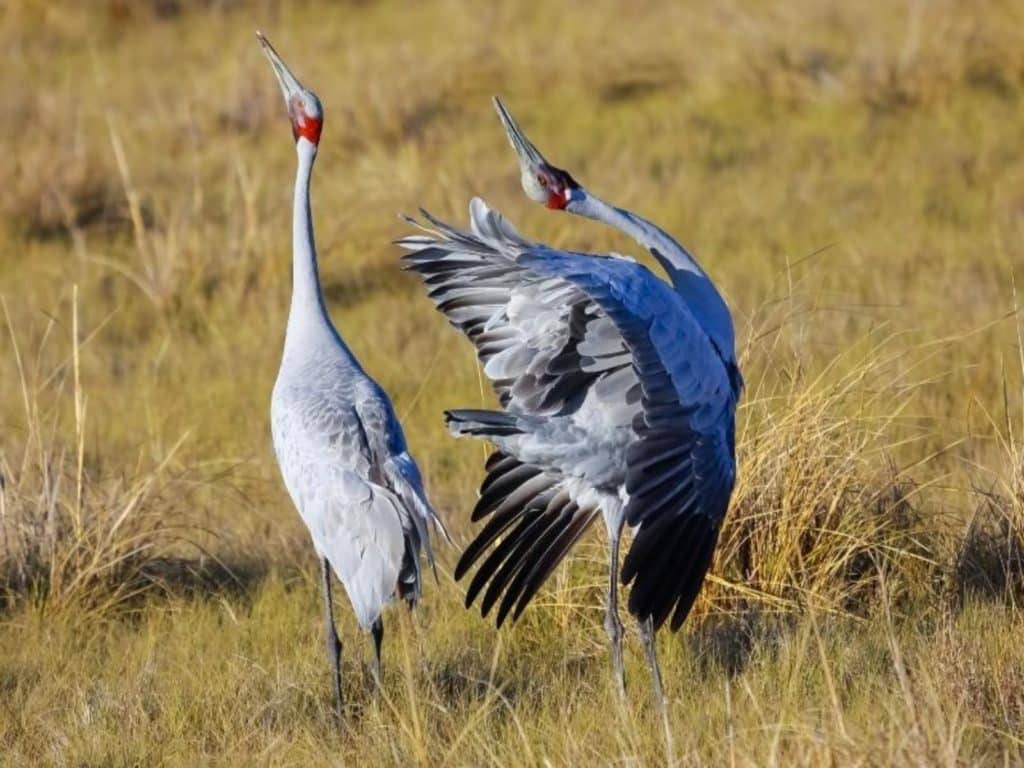
Spotlighting & Nocturnal Tours (Australia-Wide):
Australia is home to some of the world’s most spectacular wildlife. Join us for a spotlighting adventure where we will target bird species including Greater Sooty Owl, Powerful Owl, Australian Boobook, White-throated Nightjar, Eastern Barn Owl, Australian Owlet-nightjar and perhaps a glider, wombat and quoll too! All spotlighting equipment included!
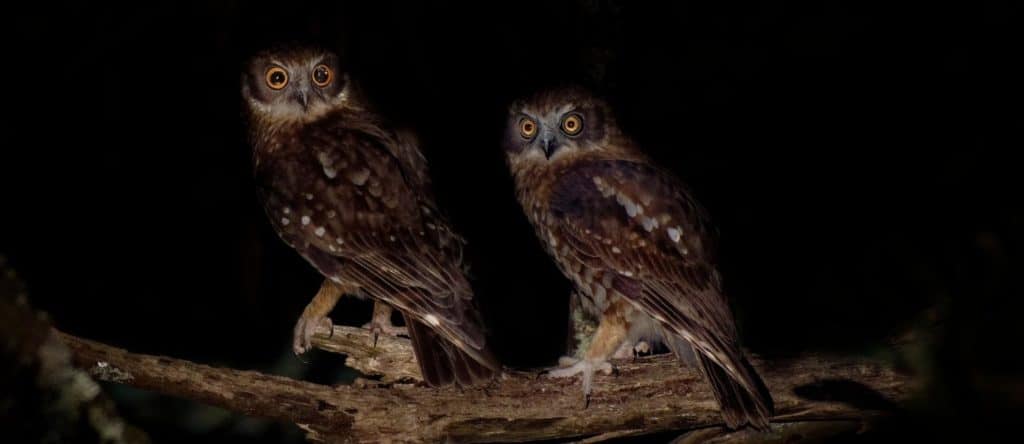
Custom Birding Tours & Multiple Days (Australian-Wide):
Need more than a day, or two (or ten?!), we can help you out! Join us on a multi-day tour as we explore some of the country’s most inspiring locations whilst connecting with some of the world’s most exceptional species! These are custom tours to suit your budgets, time frames, target species, and all our requirements. Both hardcore tours for rarities and photography bookings welcomed. We operate in all states and can put a custom itinerary together for any combination of target species. Get in touch today for more details!
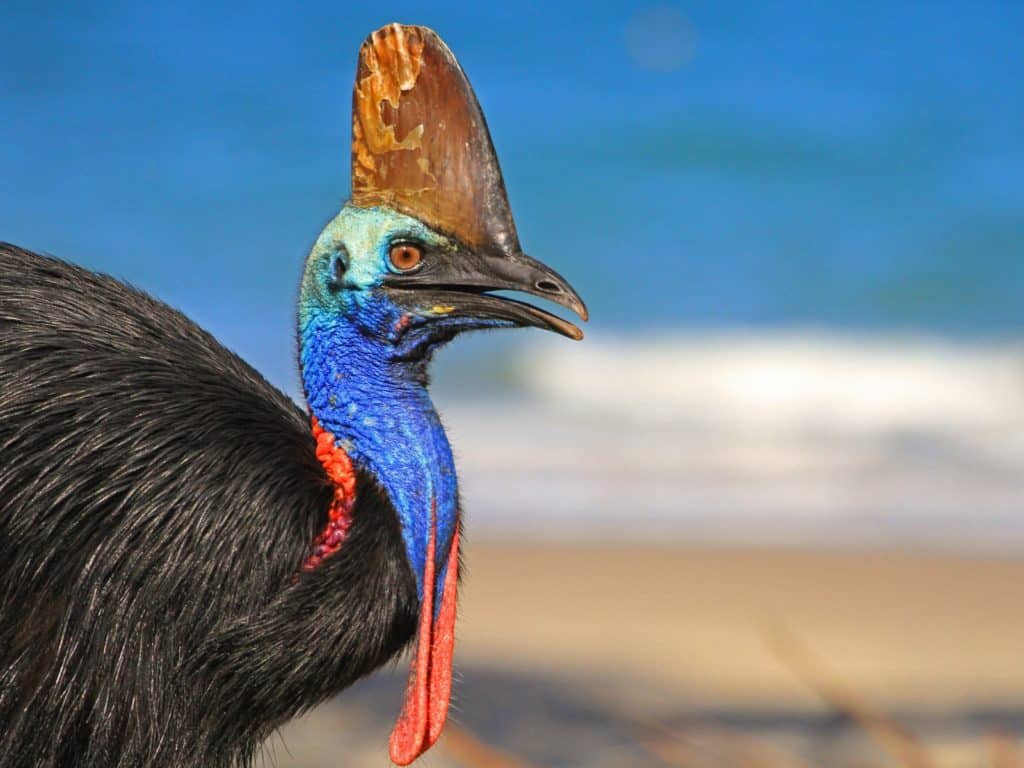
Trip At A Glance:
- Flexible Dates
- Private Groups Only
- Comfortable Vehicles / Travel
- Amazing Photo Opportunities
- Expert Private Guide
- First Aid & Covid-Safe
- Half Day (6hrs) - $340 for 1-2x pp
- Full Day (12hrs) - $570 for for 1-2x pp
- Spotlighting Only (4hrs) - $320 for 1x person
- Additional guests +$50 each
- Customised Tours start from only $350
- [email protected]
- (03) 7018 2302
- Melbourne, Victoria
- About Treeswift
- FAQ's / Terms & Conditions

Let`s Go Birding in Melbourne
Melbourne: a birding destination like no other.
Victoria, Australia’s smallest mainland state boasts some terrific birds and a wide variety of habitats. From the eastern temperate rainforests to the dry mallee scrub of the north-west, over 490 bird species have been recorded in this state.
Melbourne, the state capital, is surrounded by excellent birding sites. Close to the city are forest-clad hills, home to Superb Lyrebird, Pink Robin, Pilotbird and other moist forest specialists. A visit to Werribee Treatment Plant is a must for any birder travelling to Victoria. This extensive area of lagoons and mudflats is one of Australia’s premier birding destinations and plays host to many species of waders/shorebirds, and water birds.
East of Melbourne, the forests and heath lands of the Gippsland area contain Glossy Black Cockatoo, Ground Parrot and Eastern Bristlebird. North of the city, the dry box-ironbark forests of Chiltern are home to woodland birds such as Turquoise Parrot, Spotted Quail-Thrush, Regent Honeyeater and Speckled Warbler.
South west of Melbourne, a trip along the Great Ocean Road will be rewarded with spectacular scenery and some great birding. This area is the best place for the enigmatic Rufous Bristlebird. If you go all the way to Port Fairy you may be able to join a pelagic trip on which many species of albatross, petrels, prions and other seabirds can be observed. Finally, in the far north west of the state the “mallee” (dry eucalypt scrubland) attracts several habitat-restricted species: Malleefowl, Regent Parrot, Red-lored Whistler, Mallee Emu-Wren and Striated Grasswren.
A TEAM OF EXPERT BIRDING GUIDES
If you only have a day or two, birding around Melbourne can result in an amazing variety of birds. A great variety of habitats can easily be covered in a day’s birding and will result in sightings of many different bird species: waterbirds, raptors, parrots, cockatoos, lorikeets, honeyeaters, robins, treecreepers, flycatchers, fairy-wrens, finches and many, many more.
Let one of our experienced, knowledgeable and friendly guides show you their favourite birding spots and adjust the day to your wishes. As a starting point, please browse the sample itineraries below, then contact us to discuss. We look forward to hearing from you and showing you our special birds!
SAMPLE ITINERARIES FOR MELBOURNE BIRDING
Please find below some suggested itineraries for day tours. Our local guides are available to take you out birding for any duration. If you like to maximise the species list we can visit as many habitats as possible in order to achieve between 100-120 species, more in our spring and summer when migratory shorebirds are present. If you prefer to have a relaxed day’s birding we’ll show you the highlights of our local area, visiting a few different parks and reserves each with its own unique birdlife. Prefer to focus on bird photography? Our experienced, knowledgeable and friendly local guides would be happy to show you their favourite birding spots and adjust the day to your wishes.
If you have more time, let’s consider a multi-day birding trip further afield, such as:
Mount Pilot National Park: one of the best remaining examples of Box-ironbark Forest. It is home to birds such as the stunningly beautiful Turquoise Parrot, the endangered Regent Honeyeater, Mistletoebird, White-browed Babbler, Speckled Warbler and Painted Honeyeater;
Great Ocean Road
One of the most scenic locations in Australia. The focus of this tour is the bird life however you will be awestruck at every turn by the rugged coastlines, the pristine forests and the biodiversity that will reveal itself to you. Birds include Rufous Bristlebird, Southern Emu Wren, Gang Gang Cockatoo, Yellow-tailed Black Cockatoo, Hooded Plover.
‘Mallee' reserves of NW Victoria
Visit two of the best National Parks containing Mallee eucalypt scrubland habitat, and explore some the River Red Gum forests along Australia’s largest river, the Murray. Birds such as Malleefowl, Mallee Emu-wren, Major Mitchell’s (Pink) Cockatoo, Regent Parrot and many more can be found here.
The riverine floodplain forests of the Vic-NSW border region
With birds such as Superb Parrot, Diamond Firetail, Painted Buttonquail, Pied Honeyeater and other good species can be found, with the highlight being a night spotlighting session for the highly endangered Plains Wanderer on the vast plains surrounding these rivers.
Itinerary #1: Full-Day Best of Melbourne Birdwatching
Features: • Visits the waterfowl spectacle of the Western Treatment Plant and the dense forests of the Dandenong Ranges National Park, with many other habitats along the way. • Personalised service, travel in comfortable and reliable air-conditioned vehicle. • Wonderful photographic opportunities.
Inclusions: • Hotel pickup and drop off • National Park fees • Use of Spotting Scope, Field Guides • A bird checklist • Guiding by one of our professional and friendly guides
Some key species: Superb Lyrebird, Eastern Yellow Robin, Crimson Rosella, Red-necked Avocet, Galah.
Featured Birds and Wildlife
6 am – You will be picked up at your city hotel and taken to Dandenong Ranges National Park, approximately 40 minutes east of Melbourne. The park has an amazing upper canopy of Mountain Ash, Eucalyptus regnans, the tallest flowering plant in the world. The mid canopy features some amazing tree ferns and bracken. This is the home of arguably the best songbird on the planet, the Superb Lyrebird. We will hike approximately 1km, 0.6 miles into a site where we stand a good chance of seeing and hearing this incredible bird.
Although the Superb Lyrebird is our target species there are many other birds which live here including Eastern Whipbird, Laughing Kookaburra, Eastern Yellow Robin, Galah, Yellow-tailed Black Cockatoo and King Parrot to name a few.
After a few hours here we will head an hour south west to the Western Treatment Plant where we will add to the species list with waterfowl, shorebirds, bush birds, raptors and more. We will lunch on the go so our birding is not interrupted.
At the end of the day we will head back to Melbourne where you will be dropped off at your hotel at 6 pm.
Itinerary #2: South West Coastal Tour
Features: • Visits the waterfowl spectacle of the Western Treatment Plant and the eastern part of the scenic Great Ocean Road, with many other habitats along the way. • Personalised service, travel in comfortable and reliable air-conditioned vehicle. • Wonderful photographic opportunities.
Inclusions • Hotel pickup and drop off • National Park fees
Some key species: Rufous Bristlebird, Southern Emu-wren, Hooded Plover, Black-faced Cormorant, Chestnut-rumped Heath-wren, Striated Fieldwren, Shy Albatross, Australian Gannet
6 am – You will be picked up at your city hotel and taken to Angelsea, a bit over an hour’s drive south west of Melbourne. We will begin by searching for the Rufous Bristlebird, a species which has a very small range due to its habitat requirements. This charismatic species is a bit of a skulker, however, be patient and you may be rewarded by some wonderful views.
We will then visit a surf beach where nothing really stands between us and Antarctica. We will search the beaches for Hooded Plover, Sanderling and Double-banded Plover. We will scour the rocky outcrops for Black-faced Cormorant, a marine species of cormorant rarely seen close to shore. We will look out to sea where in windy wintery conditions various species of albatross can be seen. From here we will explore a magnificent example of coastal heathland which provides the perfect habitat for Striated Fieldwren, Southern Emu-wren and Tawny-crowned Honeyeater. Eastern Grey Kangaroos often watch on as we seek out these target species.
We will then move on to a fantastic patch of Ironbark Forest where we will search for Some of the honeyeaters, whistlers and parrots that are often encountered. Species such as Blue-winged Parrot, Gang-gang Cockatoo, Rufous Whistler, White-eared Honeyeater, Crimson Rosella, Spotted Pardalote and many others call this forest home. We then head on to the Western Treatment Plant for ducks, shorebirds, waterfowl raptors and more. Lunch will be had at the plant where we can add to our species list as we eat.
Itinerary #3: Four Habitats Tour
Our 4 Habitats Tour is a great way for any birder to see a good variety of birds in one day close to Melbourne. The four main habitat types that we will visit are farmland, dry eucalyptus forest, coastal salt marsh and wetlands.
• Visits the waterfowl spectacle of the Western Treatment Plant and the You Yangs Regional Park, with many other habitats along the way. • Personalised service, travel in comfortable and reliable air-conditioned vehicle. • Wonderful photographic opportunities.
Inclusions: • Hotel pickup and drop off • National Park fees
Some key species: Wedge-tailed Eagle, Whistling Kite, Rainbow Bee-eater (summer), White-winged Chough, shorebirds, Pink-eared Duck, Musk Duck, crakes, spoonbills and many more. Expect over 100 species.
7 am – You will be picked up at your city hotel or place of accommodation near Melbourne. We will first head to You Yangs Regional Park with an optional coffee stop on the way. You Yangs Regional Park is a dry eucalyptus forest which attracts many types of birds including a variety of honeyeaters such as White-plumed Honeyeater, New Holland Honeyeater and Yellow-faced Honeyeater. Quite often Australia’s largest raptor, the Wedge-tailed Eagle will soar overhead as it searches for prey. Other raptors we may encounter include Brown Goshawk, Collared Sparrowhawk, Whistling Kite and Brown Falcon. In Spring/Summer, the park is home to some northern migrants including Rufous Whistler, Rainbow Bee-eater, White-winged Triller, Olive-backed Oriole and some of the cuckoos such as Fan-tailed Cuckoo, Shining Bronze-cuckoo, Horsfield’s Bronze-cuckoo and Pallid Cuckoo. Another bird that is frequently seen here is the White-winged Chough which lives in large groups and builds wonderful mud nests. Some mammals that we may see are Black Wallaby, Eastern Grey Kangaroo and Koala.
11 am – We will drive the short distance over to the Western Treatment Plant where we will spend the rest of the day. This site holds an incredible amount of waterfowl, bush-birds and raptors all year round. During our Spring/Summer, the plant is home to up to 30 species of shorebird which migrate from the northern hemisphere. We will scan the many ponds for ducks, cormorants and grebes including Pink-eared Duck, Australian Shoveler and the incredible Musk Duck. We will search the many reed beds for Australian Spotted Crake, Buff-banded Rail and Spotless Crake. We will endeavour to find Royal Spoonbill, Yellow-billed Spoonbill and up to 100 other species in Melbourne’s premier birding destination. We will have lunch at a place where the birds are plentiful so that we won’t miss a thing. We will continue birding until 4 pm and have you back at your accommodation at 5 pm.
Our team at birdingmelbourne.com is part of the Bellbird Tours network of birding guides. We have local birding guides who are experts in various locations across Australia including Adelaide , Perth and Sydney among others.

Birds of Victoria
by Around And About Team | Jan 28, 2021 | Animals , Australia , Day tours , family , Summer times , tours , Travel , Victoria , Winter Getaway | 0 comments
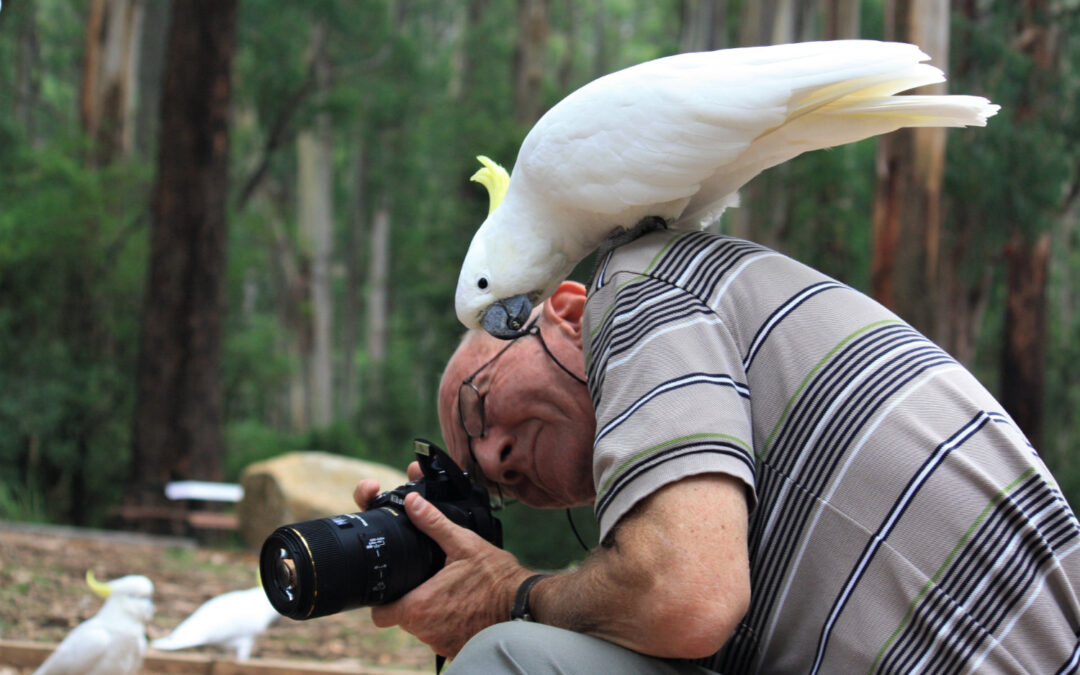
The diverse ecosystems across the state of Victoria provide natural habitats for over 450 species of birds and attract birdwatchers from all over the world. From temperate rainforests to scrublands, alpine forest, wetlands, grasslands and seaside habitats, the environmental biodiversity of the state gives passionate birdwatchers many options.
Victoria’s state bird is the helmeted honeyeater (Lichenostomus melanops cassidix), a subspecies of the yellow-tufted honeyeater. About 20 cm in length, they are actually an endangered species with only 200 left at last count (in 2018). The best place to see the helmeted honeyeater is on the banks of the Woori Yallock Creek near Yellingbo east of Melbourne.
All around Melbourne in inner city and suburban backyards, on creeks, near rivers and by the seaside, thousands of birds live, breed and play, delighting birdwatchers and avian enthusiasts of all ages. Grab your field guides, identification books or apps and get started.
What is the best time to go bird watching?
The best time to see birds in their natural environment is early morning when they are stretching their vocal cords and welcoming the day, or at dusk when they are winding down and saying goodnight to the world. Book in for one of our private customised tours and you can be set up and ready to observe the avian world at a time that suits you, whether it’s a dawn concert or an evening song that most inspires.
Where to see birds in Victoria.
Lyrebirds are shy creatures, more often heard than seen, but patient, quiet twitchers can spot them in various locations around the state. Close to Melbourne, the trails in the hills throughout the Dandenongs are a great place to see them. You’ll also be able to observe currawongs, magpies, rosellas, fairy wrens and cockatoos in this area.
In Kinglake National Park, also close to Melbourne, you can see the gang-gang cockatoo, black cockatoos, a range of honeyeaters (crescent, brown-headed, white-naped, white-eared) robins, quail thrush, whipbirds, fantails and finches. The forest has replenished itself since the devastating bushfires that swept through the area in 2009 and now blooms with plant species that provide perfect habitats for our feathered friends.
At Point Nepean National Park, at the far end of the Mornington Peninsula, twitchers have the opportunity to see birds like hooded plovers and Australasian gannets in their preferred coastal environments. With Around and About small group tours you can customise a Mornington Peninsula day trip so that you can see the sights of this region, enjoy the towns, wineries and produce, as well as the birdlife.
The Great Otway National Park has a diverse range of habitats. The forests give shelter and homes to southern emu-wrens, blue-winged parrots and bowerbirds. In the coastal areas you can see the Rufous Bristlebird and, on occasion, the Southern giant petrel. While you walk the hiking trails, visit waterfalls and picnic by creeks you will spot plenty of birds living their best life.
How to get to bird watching locations in Victoria.
Book a tour for your bird watching group with Around and About Travel and we can create an itinerary that takes you exactly where you want to go. If it’s penguins that you love, join in our Phillip Island Penguin Tour and enjoy a day out exploring before you watch the little fairy penguins waddle up the shire to their burrows.
If it’s birds of prey you’re interested in, don’t miss our day trip to Healesville Sanctuary in the Yarra Valley. The Spirits of the Sky display, in the purpose-built flight arena, allows keepers to show off the magnificent power of the spectacular parrots, wedge-tailed eagles and black breasted buzzards that originate in the area. Feel the power of their mighty wings as they whiz overhead and interact with their trainers. It’s a spectacular demonstration that you will not want to miss.
Are you a twitcher? What are your favourite Victorian bird watching locations?
Share with us some of your favourite birds.
If you liked this article please share:
Keep in touch. Subscribe to our blog for more Victorian travel stories
- First Name * Please enter your First name
- Family Name * Please enter your Family name
- Date of birth MM slash DD slash YYYY Please enter your date of birth
- Email * Please enter your email address
- CAPTCHA Just checking that you are human and not a robot
Tours From: $99.00

Submit a Comment Cancel reply
Your email address will not be published. Required fields are marked *
Save my name, email, and website in this browser for the next time I comment.
Recent Posts
- Following the Silo Art Trail in Victoria with Around and About Travel
- Indigenous Tourism in Victoria
- WildLife Wonders, A Walk on the Wild Side
- Rip Curl Pro at Bells Beach
- What to do in Melbourne for the April Grand Prix
Recent Comments
- Around And About Team on The story of the Loch Ard Shipwreck
- rodney anthony on The story of the Loch Ard Shipwreck

Firetail Birdwatching Tours
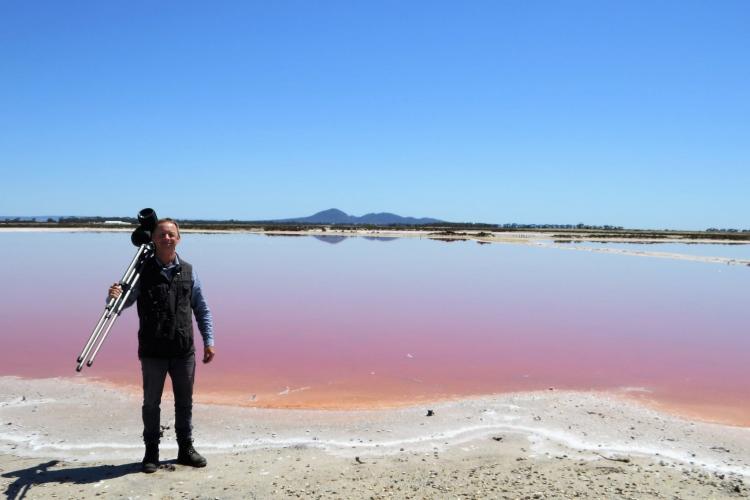
Firetail Birdwatching Tours with guide Simon Starr is Victoria’s longest running specialist guided bird-watching company with most tours starting and finishing in Melbourne.
Firetail Birdwatching Tours offer a wide variety of guided birdwatching, bird photography and general nature tours throughout the year across Melbourne, Victoria and South-Eastern Australia. Transport in a comfortable four wheel drive vehicle. Use of a Swarovski ATX95 telescope. Local knowledge gained after 25 years of exploring this region. Checklists provided. Drinks and snacks provided
For every tour Simon takes into account the widely varying conditions that occur here in Australia as well as catering to individual interests, to maximize sightings and give you the best experience possible.
Victoria is Australia’s smallest mainland state but one of its best kept secrets, where it is possible to visit all of South East Australia’s important habitats within just a few hours driving with 400 species recorded annually. Their website Birding Victoria includes a huge amount of information on birding sites plus links and resources. Last year's Annual 10 day Megatour run every November recorded 283 species.
More To Explore
See & do.
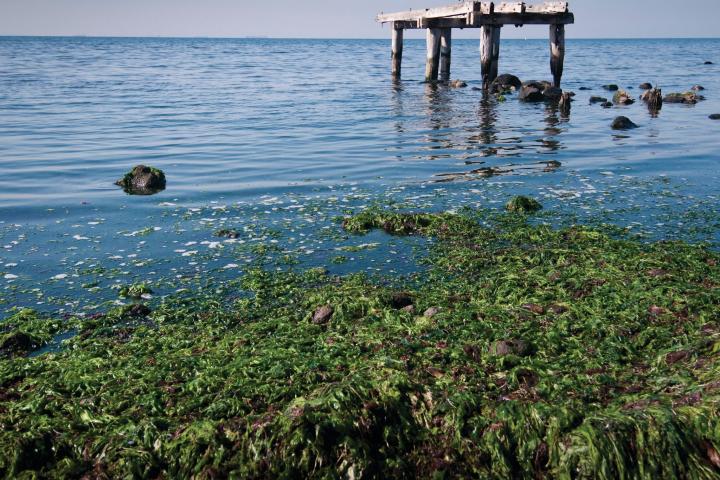
You might also like
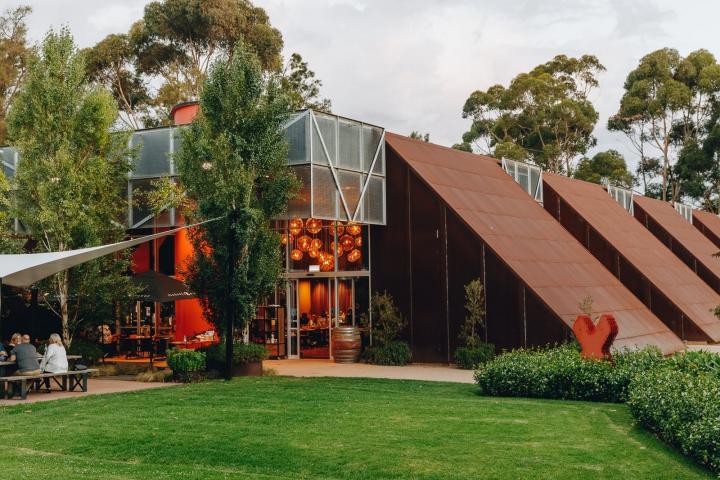
#visitwerribee
Follow @visitwerribeeandsurrounds.
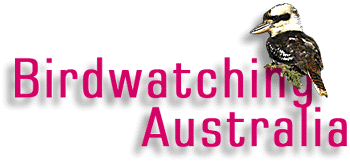
Firetail Birdwatching Tours
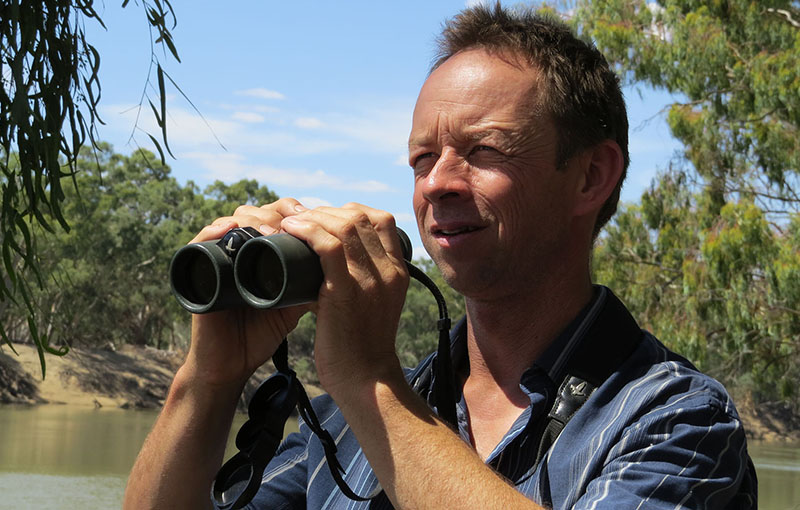
Firetail Birdwatching Tours , operated by Simon Starr, is Victoria’s longest running specialist bird guiding company.
A wide range of itineraries are offered from half a day to over a week, specialising in birding and nature tours across the entire state of Victoria and adjacent New South Wales. The Birding Victoria website aims to assist visiting birders in finding south-eastern Australia’s special birds whilst also offering full details of potential tours.
A huge amount of information is listed on birding sites and individual species, plus there are links to a wide range of relevant websites and resources. Victoria is the smallest mainland state but one of Australia’s best kept secrets, where around 400 bird species occur and it is possible to visit all of southern Australia’s important habitat types within just a few hours driving. From temperate rainforest to semi-arid woodlands and plains, the range of experiences is spectacular.
Whether you only have time for a half day visit to the world renowned wetlands at Werribee near Melbourne, or wish to fully explore the region in a week or more, we can organise a birding tour for you. All inclusive group package deals are also offered.
Our relaxed and friendly tours are run on a simple ethos – to focus on you, so that you can focus on the birds.
Meet the Guide
Hosts: Simon Starr
Mobile: 0438 520 780 ( Int. +61 438 520 780)
Email: [email protected]
Facebook: www.birdingvictoria.com.au
Contact the host
Email Address
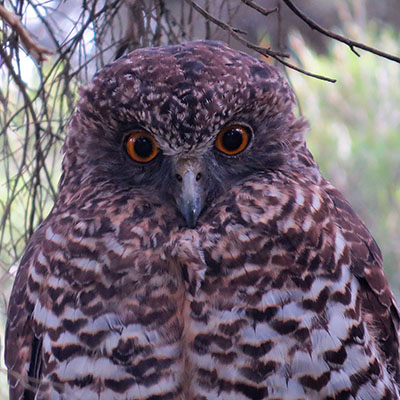
Traveling BC
Discover the beauty of BC
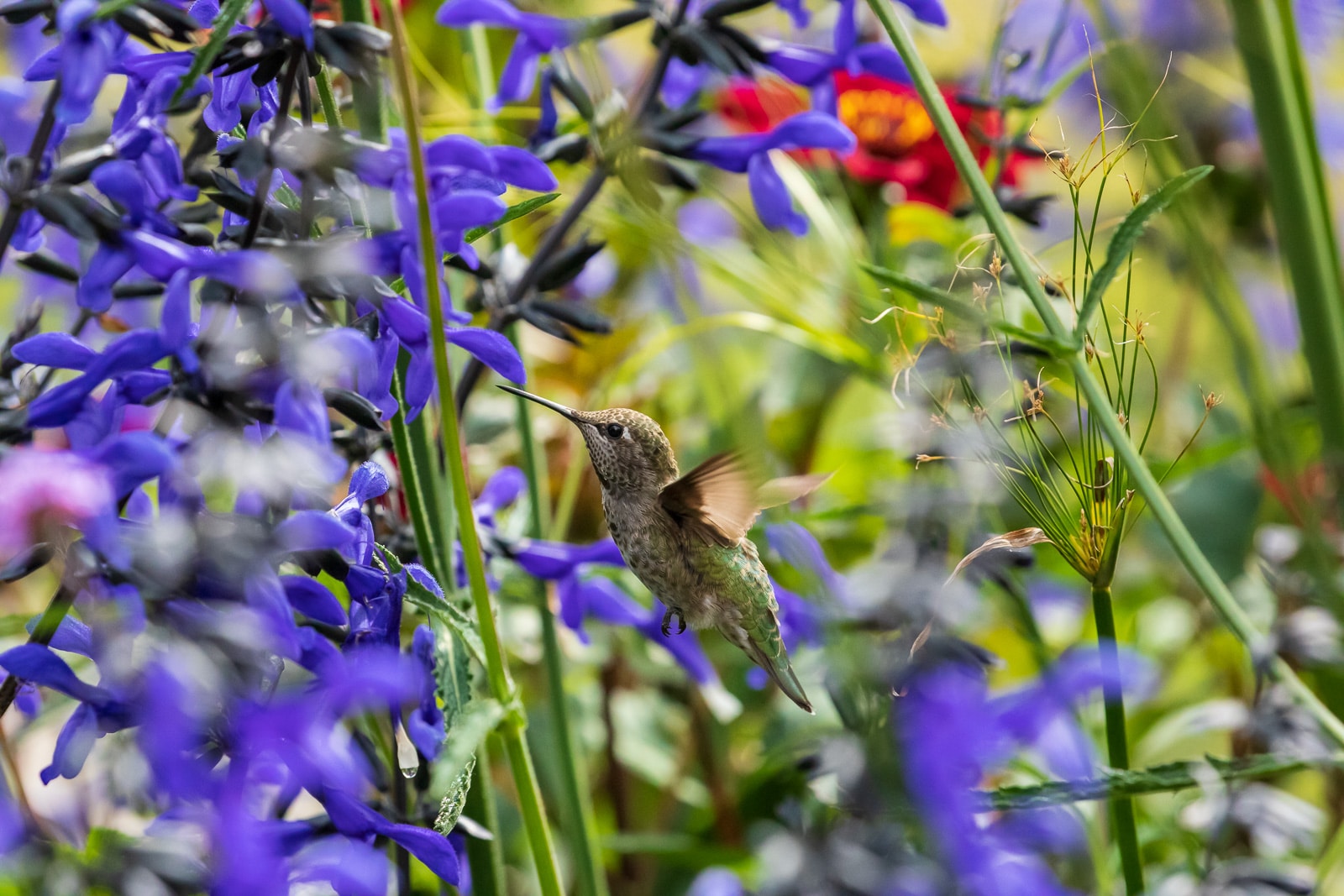
Disclaimer – This post may contain ads and affiliate links that help keep Travelling BC running. If you purchase through these links, we may receive a commission, at no cost to you. Thank you for your support! Learn more.
5 Best Birdwatching Spots in Victoria, BC
Victoria, BC is a birdwatcher’s paradise. Home to hundreds of bird species and with a mild climate, this beautiful coastal city offers some excellent year-round birding opportunities.
With numerous parks and ecosystems, you’ll have plenty of places to search for species you haven’t seen yet. But, like most of us, you probably don’t have all the time in the world to find the best birdwatching spots around Victoria. So we’re here to help!
We cover some of the best birdwatching spots around Greater Victoria, BC. These are our favorite places to head with a set of binoculars, spotting scope, or camera with a long lens attached. Hopefully you’ll be able to cross a few lifers off your list at these locations!
Where Are the Best Places to Go Birdwatching in Victoria, BC?
1. esquimalt lagoon.
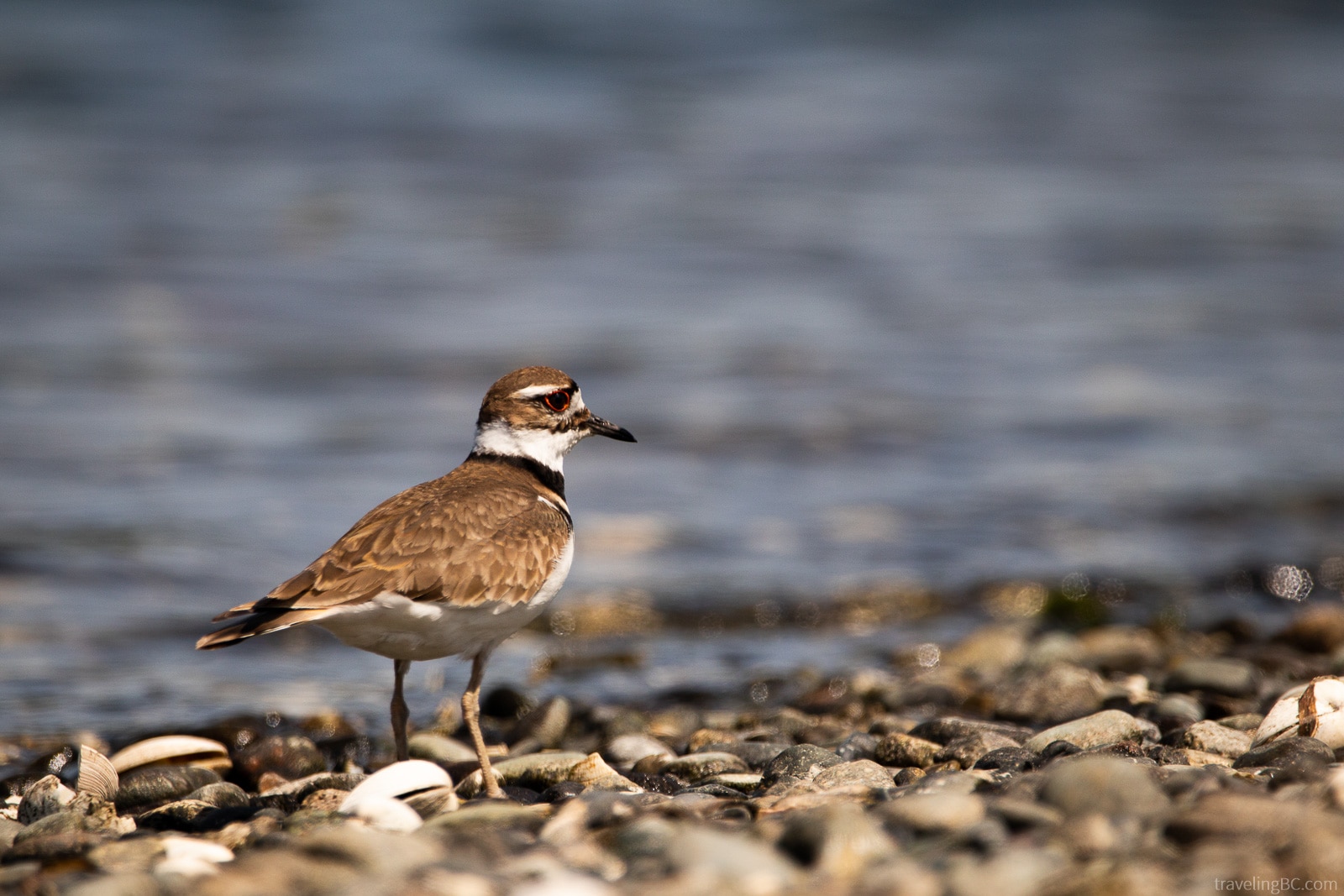
One of the best places to go birdwatching in Victoria, BC, is at Esquimalt Lagoon . Located along the Colwood waterfront, this National Migratory Bird Sanctuary (one of seven in Canada!) is a fantastic spot to spot all kinds of species. It’s also one of the most beautiful sandy beaches in Victoria !
The 2-km long sandy Coburg Peninsula separates Esquimalt Lagoon and the ocean, which are connected only by a narrow tidal channel. On the lagoon’s inland edges, you’ll find Hatley Forest and the impressive Hatley Castle. Fort Rodd Hill and the Fisgard Lighthouse also are nearby the lagoon.
Waterfowl (like American wigeons, geese, swans, and surf scoters), gulls (like California and Glaucous-winged gulls), and shorebirds (such as killdeers and oystercatchers) are abundant around Esquimalt Lagoon. Also look for birds like kingfishers, bald eagles, and sparrows around the park.
It’s not surprising to see several birders with DSLR cameras here. Esquimalt Lagoon makes for some excellent photography opportunities during the golden hours!
2. Panama Flats
Panama Flats is a 116-acre open park area consisting of former agricultural fields and flood plains. The park features a range of habitats, from shallowly flooded fields to shrubby parkland, which are home to a diverse number of bird species.
If you want to see wetland birds, Panama Flats is one of the best places to head in Victoria for some birdwatching. Here, you’ll find species like marsh wrens, red-winged blackbirds, and all kinds of sandpipers. It’s also a good place to spot larger species, like geese, great blue herons, and even sandhill cranes.
Swallows and sparrows are also common around Panama Flats. Bald eagles like to sit in the tall trees on the edges of the fields, and turkey vultures circle overhead. And you might even spot a family of California quail — an introduced species but still fun to spot — hiding in the bushes here!
3. Witty’s Lagoon Regional Park
Witty’s Lagoon Regional Park is a birdwatcher’s dream, with over 160 bird species spotted here. You don’t want to forget your binoculars when visiting this seaside park!
Located in Metchosin, the 56-hectare Witty’s Lagoon features a gorgeous coastal temperate rainforest, saltwater marsh, rocky headlands, sandy bluffs, and a beautiful beach. From rufous hummingbirds and Swainson’s thrushes to belted kingfishers and sooty shearwaters, you’ll have lots to see on an outing to this regional park.
Not only that, Witty’s Lagoon also has plenty of other things to do, besides birdwatching. Sitting Lady Falls, one of the best waterfalls around Victoria , is located in the park. Also, there are several excellent trails to explore through the woodlands and to the beach, as well as at Tower Point.

4. Swan Lake Christmas Hill Nature Sanctuary
Swan Lake Christmas Hill Nature Sanctuary is a top, year-round birdwatching spot on the northern edge of Victoria’s downtown core. Here, you’ll find two main ecosystems: Swan Lake with its surrounding wetland, and the Gary Oak forest of Christmas Hill.
To see all the birding that the park has to offer, we recommend following the 2.5 km Lake Loop Trail. It circles Swan Lake, with an offshoot where you can adventure up to the summit of Christmas Hill. Along the way, you’ll cross over Swan and Blenkinsop Creeks, walk along boardwalk, and pass by the Nature House (an interpretive information centre).
Around the lake, look for birds like marsh wrens, ringed neck ducks, and mallards. Anna’s hummingbirds, downy woodpeckers, common yellowthroats, and bushtits are common in the shrubs and surrounding woods.
This oasis of green is nestled within the city which makes it easy to visit, even if you don’t have a vehicle. The Lochside Trail also bypasses the park’s southern edge, making it a great option to visit for cyclists.
5. Cattle Point and Uplands Park
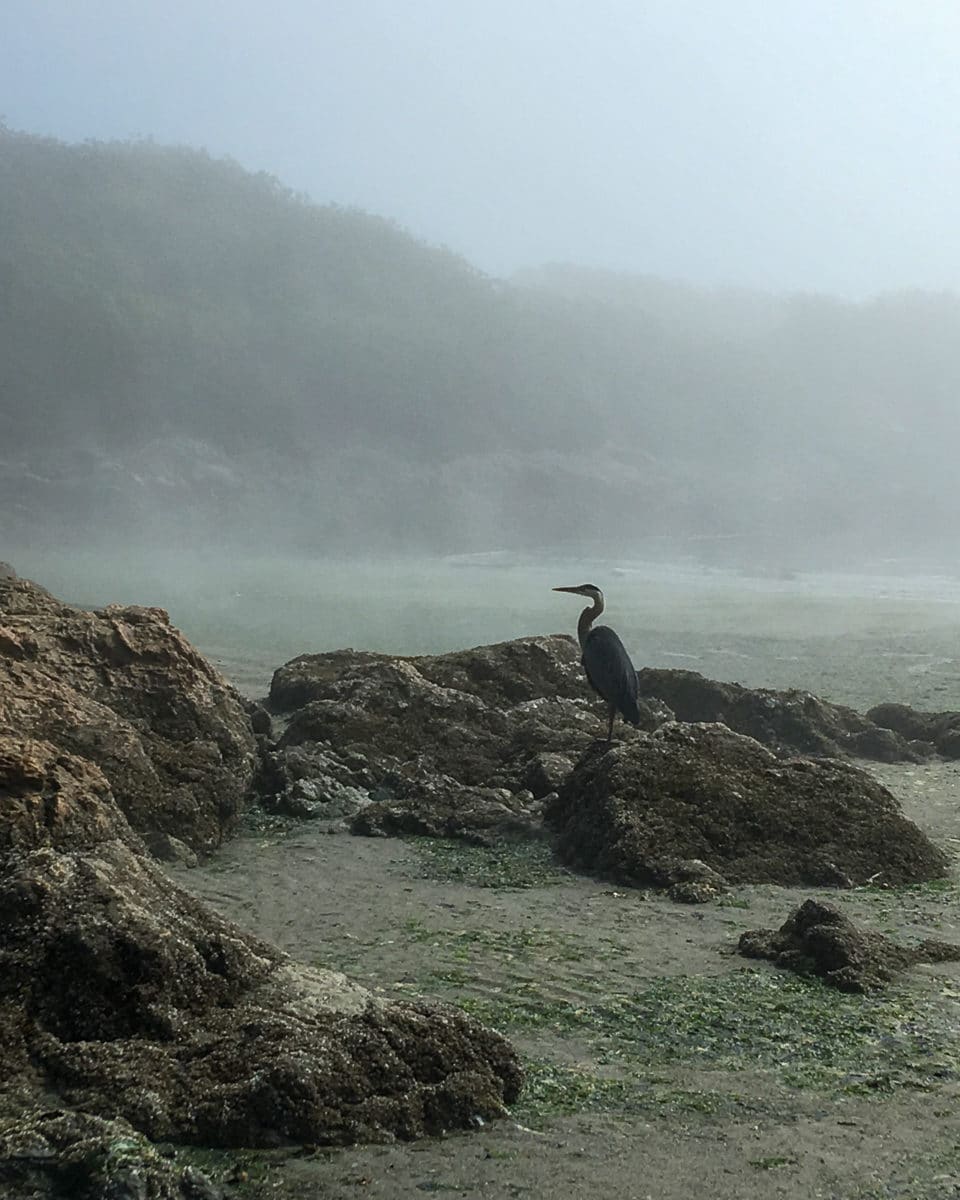
Cattle Point and Uplands Park, two adjacent parks in Oak Bay, offer excellent birdwatching opportunities. Here, you’ll find a mix of rocky coastline, shrubby parkland, and rare Gary Oak meadows.
Cattle Point is a good place to spot waterfowl and shorebirds. Additionally, it is one of the best places in Victoria for tide pooling , and is a great spot to watch the sunrise or stargaze.
Uplands Park is just inland from Cattle Point, across Beach Drive. The park is excellent for spotting warblers and other songbirds. We’ve also heard barred owls in the forested areas. Uplands Park protects some rare Gary Oak meadow and is a fantastic place to head in the spring to enjoy the sea of blooming Camas flowers while looking for birds.
As an added bonus, the gorgeous Willows Beach is just to the south of these two parks. Willows Beach is one of the most beautiful beaches in Victoria , and also offers some decent birdwatching.
Top Travel Tips & Resources for Victoria, BC
- Travel Insurance – If you’re travelling internationally, travel insurance is a must for any trip. Being covered by insurance is especially important when you’re going to an adventure-filled place like British Columbia. If you injure yourself while adventuring, you want to have insurance! We recommend using SafetyWing for international travel insurance. They are affordable and have great policies for travellers, digital nomads, and remote workers. Also, SafetyWing provides COVID-19 coverage, which many other insurance companies don’t cover.
- Car Rental – We find the best deal on vehicle rental prices using RentalCars.com . They compare the prices for different car rental companies so you can find the best deals out there!
- Accommodations – We prefer booking all of our hotels, hostels, and other accommodations through Booking.com because they have a flexible cancellation policy. Also, there are lots of different options on their platform, from hotels to vacation homes. Alternatively, Expedia and Hotels.com are good for booking accommodations. For vacation home rentals, VRBO is an excellent choice (they have lower fees than Airbnb, many of the same properties, and are more ethical).
- Flights – You’ll find many good flight deals on Skyscanner or Google Flights. You can book flights through these websites and they’ll help you find the best prices and flight times. If you fly at less popular times (e.g. mid-week or red-eye flights), you can also save some money.
- Tours – Get the most out of your vacation by taking a guided tour! This is a great way to see the city, adventure to exciting new locations, and learn about the local culture. Viator or GetYourGuide are great options for booking tours.
Related posts:
- Esquimalt Lagoon, Victoria: Complete Beach Guide
- 9 Wheelchair Accessible Beaches around Victoria, BC
- 36 Best Things to Do in Victoria, BC
- 10 Best Sandy Beaches in Victoria, BC
- 11 Most Beautiful Beaches in Victoria, BC
- Where to See Wildlife Around Victoria, BC

Hey, I'm Nicole! I've travelled all over the world but my favorite place is British Columbia. I've lived in Victoria, BC since 2019 and spend most of my free time travelling around BC. My goal is to explore as much of this beautiful province as possible. Along the way I'll be sharing travel tips with you!
21 Unusual Things to Do in Vancouver
11 best things to do in ucluelet.
Ultimate British Columbia: Coast & Grasslands
- Relatively easy and productive birding among the most scenically impressive areas of the province.
- Up to 200 species of birds; including many warblers, a dozen shorebirds, six wrens, five vireos, four hummingbirds, and many others.
- Spectacular mammal viewing with a great chance at black bears, orcas, grey whale, sea otter, elk, marmots and many more goodies.
- Visiting some renowned tourist hotspots and travelling off the beaten path too!
- Two spectacular boat trips.
- The chance to relax in the evenings over west coast cuisine and wine selection.
Tour Overview
From the temperate rainforest of the Pacific ocean to the grassland and desert areas of the Okanagan, we visit a diverse set of habitats on this birding tour of British Columbia.
We begin in Vancouver on the mighty Fraser River delta. This city’s position makes it a huge draw for birders from around the world who seek migrants, breeding birds and vagrants. Highlights here include exciting shorebird viewing in Boundary Bay, montane birds of the North Shore Mountains and seabirds and rainforest specialties of Stanley Park.
Vancouver Island awaits us after a two hour ferry ride. We’ll spend three days exploring birding hotspots near Victoria such as Swan Lake and Martindale Flats, and take a whale-watching tour to view orcas up close. We’ll visit the wild west coast near Tofino for a pelagic tour that opens up a world of possibilities for seabirds, and comb the beaches in hopes of whimbrels, eagles and perhaps even a wolf.
From here we’ll traverse inland to the famed Okanagan region, known not only for its vineyards but also for avian diversity. Areas such as Kilpoola Lake host Common Poorwills and perhaps even Sage Thrashers, while Vaseux Lake is a site where we could have our highest daily species totals for the trip.
Overall this unique British Columbia birding tour offers the chance to see an incredible array of birds in addition to some fantastic wildlife viewing. British Columbia is a magnificent province that has much to offer the naturalist explorer, from wild Pacific coastline to alpine tundra, and from arid desert to lush rainforest and more.
Dates & Prices
Dates & prices, what's included, tour price includes.
- All accommodation (Good quality)
- All breakfast and lunches
- Two boat trips (weather permitting)
- Ground transportation
- 1 guide with 4 - 8 participants, 2 guides in 2 vehicles with 9 - 12 participants
- All park, conservation and entrance fees
Tour Price Does Not Include
- Flights to and from Vancouver
- Evening meals (group will dine together, but pay individually)
- Travel Insurance
- Items of a personal nature
- Taxes (5% GST)

Day 1: Arrival in Vancouver
Our Ultimate British Columbia birding tour begins in Vancouver where we meet at our hotel for dinner on the first night. We’ll discuss our plans to explore Canada's most diverse province over the coming days. Night near the Vancouver airport.
Day 2: Vancouver area
We will hit the ground running by exploring a number of birding sites near the airport and in the Vancouver area. Iona Island is one of the best sites in a city that is renowned for good birding. We’ll listen for the chattering of Bewick’s Wren, Warbling Vireo and Bushtit as we explore this part of the Fraser River Delta. Iona is yet another primo site for shorebird and waterfowl viewing, and rarities are possible. A Spoon-billed Sandpiper was sighted here once! In one flock, we may see all seven species of swallows possible in Western Canada! From here we’ll head right into picturesque downtown Vancouver and through the rainforest environs of Stanley Park. We’ll cross over to the north shore for dinner. Night in North Vancouver.
Days 3 - 5: West Coast and Tofino Pelagic
This morning we’ll head upslope for some montane forest birding. Weather permitting, from Cypress Mountain we’ll have unreal vistas over the city while Vaux’s and/or Black Swifts parade by. This is our best spot on the tour for Black-throated Gray Warbler, Black-headed Grosbeak and Anna’s Hummingbird. At Cypress, where the 2010 Olympics were hosted, we’ll hear and perhaps see a displaying male Sooty Grouse booming one of the world’s lowest frequency songs. More obvious songsters include Olive-sided and Pacific-slope Flycatcher, Cassin’s Vireo, Pacific Wren, MacGillivray’s Warbler, Western Tanager along with Varied, Hermit and Swainson’s Thrush.
After this we’ll board a ferry from Horseshoe Bay to Nanaimo, and from the deck we can scan the waters of the Strait of Georgia for seabirds such as Brandt’s and Pelagic Cormorant, Rhinocerous Auklet, Marbled Murrelet and Pigeon Guillemot. Upon arrival we’ll get the sense of the relaxed feel of Vancouver Island as we traverse to the real west coast, stopping at a grove of majestic Douglas Firs, some more than 800 years old! Pacific Wren provides the complex audio backdrop to this wondrous ecosystem.
Nearing the coast we smell the ocean air and investigate the wild Long Beach, where we look for Black Oystercatcher, Sanderling, Hammond’s Flycatcher, Wilson’s Warbler and Chestnut-backed Chickadee, among others.
The next morning, weather permitting, we depart on a pelagic adventure, and we don’t have to go far to find excitement. Gray or Humpback Whales might be sighted in near-shore waters and we’ll visit a small colony of Tufted Puffins. Once arriving offshore at the deep Clayoquot Canyon we may encounter ocean-faring species such as Black-footed Albatross, Pink-footed and Sooty Shearwaters, Common Murre, Fork-tailed Storm-petrel, Red-necked Phalarope and Ancient Murrelet, among many others. Blue Sharks, Rizzo’s Dolphins and Northern Fur Seals are a possibility and we have twice seen the enigmatic Short-tailed Albatross, a species that nests in Japan. Surprises await us on this six-hour tour.
Our second full day in the Pacific Rim area allows a backup day for the pelagic tour and otherwise more exploration of the ethereal rainforests in this area. We’ll hike another old-growth trail, scan for Pacific Loons and scoters over expansive beaches and visit the town of Tofino, where Bald Eagles are more common than House Sparrows. Nights in Ucluelet.
Days 6 - 7: Victoria
This morning we’ll commute south to the provincial capital of Victoria, stopping en route to check an estuary for wildlife. Raccoon, Mink, and River Otter are common here. We’ll see why the southeastern part of Vancouver Island is so attractive to retirees. Once in in Victoria we’ll settle in and have some down-time to see the famed Inner Harbour. When it’s time for more birding we’ll head for Royal Roads University campus to clean up on western specialties like Hutton’s Vireo, Western Wood-Pewee and Red-breasted Sapsucker. Suburban Victoria has the highest density of Cooper’s Hawks in North America and Barred Owls are common in the city parks. We’re not done with our ocean watch however, and we’ll scan for Glaucous-winged, Western, and lingering Mew Gulls. Great Blue Heron, Wandering Tattler and Harlequin Duck could be highlights at Clover Point. One day we’ll take a three-hour boat tour into Juan de Fuca Strait specifically to search for Orcas up-close and personal, as they munch on Chinook salmon. Humback whales are making a comeback and are a probable sighting, along with two species of Sea Lions.
In the evenings we’ll have a chance to relax amid Victoria’s charming ambience and perhaps enjoy a craft brew and some local seafood treats. Nights in Victoria.
Day 8: Manning Park
Keeping the flow, we depart Victoria and return on a different ferry back to the Lower Mainland, this time stopping at nearby Reifel Refuge. This renowned bird sanctuary will give us a great chance to get a closer look at some species. Resident Sandhill Cranes are of the friendly variety, and they can wander by with newly-hatched colts while we enjoy a picnic lunch. We may see a lingering Snow Goose, a chattering Marsh Wren and predators such as Peregrine Falcon and Great-horned Owl while at Reifel. Nearby, we may try for a roosting Barn Owl before driving to the Cascade Mountains. Night at Manning Park Lodge.
Day 9 - 11: The Okanagan
Manning Park is a stunning, mountainous birding venue. Depending on the snowpack in the mountains, we may be able to drive fairly high up into the montane zone to pick up some higher elevation species such as Boreal Chickadee, Pine Grosbeak, Clark’s Nutcracker and Spruce Grouse. At Lightning Lake we’ll have a look in the Engelmann Spruce forest for both species of Crossbill, Canada Jay and Northern Goshawk. We visit a roadside site where American Dipper nests. After lunch we’ll continue east and soon enter the Great Basin ecosystem. Nighthawk Road is a great introduction to sagebrush birding where hopefully we’ll catch Brewer’s and Lark Sparrows singing in the evening and with much luck we could encounter something rare such as Black-throated Sparrow or Sage Thrasher. These birds seem to arrive annually from south of the border, which is just over the hill. We arrive in the splendid Okanagan Valley in early evening and prepare for two final days of birding— possibly the best yet.
While in the Okanagan we’ll explore the best options for sagebrush and dry forest birding. Small lakes will hold plenty of ducks including Cinnamon Teal and Redhead. Near Oliver we’ll watch breeding Wilson’s Phalaropes try to out-compete Bobolinks for our attention while we search grasslands and patches of water birch for more amazing birds. At White Lake we’ll look and listen for Grasshopper Sparrow and Gray Flycatcher. At Vaseux Lake we’ll investigate the riparian areas for migrant surprises while listening to Canyon and Rock Wren both singing from the cliffs above (Marsh, House, Bewick’s and Pacific Wrens are also present!). We’ll scan for large and small birds alike, including Golden Eagles across the lake and Rufous, Black-chinned and Calliope Hummingbirds in the forests. Lewis’ Woodpecker, Williamson’s Sapsucker, Lazuli Bunting and Pygmy Nuthatch each have their favourite tree species to cling to. An evening foray might produce a Common Poorwill or Flammulated Owl.
If we need a breather there’s always a nearby winery to lunch at, or we can dip our feet into the warm waters of Osoyoos Lake nearby our hotel. Nights in Osoyoos.
Day 12: Return to Vancouver
On our final full day we have some time for more birding prior to returning on a four-hour drive to Vancouver. This leaves time for exploring since we take a different route—one takes us through other scenic mountains. We’ll be driving through areas of contiguous forest and may have time to detour and look for bonus birds. Night in Vancouver.
Day 13: Departure
Our British Columbia birding tour ends today. Breakfast is available, but you can depart for flights home anytime today. If you are carrying on to our Boreal Extension, you will join the guides for a morning flight to Fort St. John to truly round out your Ultimate British Columbia tour!
What to Expect
Overview Our Ultimate British Columbia tour is primarily a birding tour, but we will also look for other wildlife and enjoy the natural beauty of British Columbia.
The daily travel schedule varies to account for weather, bird species and habitat, but it is a fairly fast-paced tour due to the variety of habitats, locations and large distances we cover during this tour. Most mornings we are out early before breakfast, but return to have breakfast around 8. We will spend the remainder of our morning birding, before a leisurely lunch around noon. Afternoons will be either spent driving to our next destination, or birding with a possible break to recharge. In the evenings we will relax after dinner, but there are some night excursions scheduled to search for owls and other nightlife. These are always optional.
Food Breakfast is usually at the hotel after a morning in the field. Lunch is often at a restaurant, apart from a few picnics. Dinner is always at a good restaurant not far from our accommodation. During dinner we usually discuss the day’s activities and review the list of birds seen and heard.
Accommodation Accommodations during the tour vary but are all charming or luxurious, spacious and comfortable.
Walking For the most part, the walking on this tour is suitable for everyone. However, we will occasionally encounter slippery trail sections or uneven terrain, and we may have a short climb or two. The longest walk potentially will be our search for Flammulated Owl and Common Poorwill, requiring us to walk on an unpaved road at night, 2-3 km (1-2 miles), before turning back and doing that same distance again. Given that it is nighttime, the walk could be somewhat intimidating, however we are in a group and have portable flashlights to make this a doable endeavour for everyone.
Driving There is a fair bit of driving during this tour, with some daily driving stints of 2-3 hours. The longest drive will be 5 hours, returning to Vancouver. Roads can be twisty in some places.
Climate The tour will take place during BC's summer, traditionally a warm to hot time of the year, so rain is possible, although uncommon. That being said, we potentially visit some high altitude areas, where wind is a potential hassle. We will go on some night excursions and may encounter mosquitos. During this tour we will visit the alpine, subalpine, desert, coast and more. This means a high variety of temperatures and weather circumstances. Bring short and long-sleeved shirts/sweaters, a poncho/raincoat and both long pants as well as short.
Featured Wildlife
While we cannot guarantee sightings of the birds or mammals listed below, we believe that encountering these species is quite likely during this tour.
- Ancient and Marbled Murrelets
- Tufted Puffin
- Barrow’s Goldeneye
- Sooty and Dusky Grouse
- Williamson’s, Red-naped, and Red-breasted Sapsucker
- Lewis’s Woodpecker
- Canyon and Rock Wrens
- Flammulated Owl
- Common Poorwill
- Calliope Hummingbird
- Black-chinned Hummingbird
- White-throated Swift
- Yellow-breasted Chat
- Gray Flycatcher
- Black-throated Gray Warbler
- Yellow-bellied Marmot
- Mountain Goat
Past Tour Checklists
View the list of birds and other wildlife we encountered on our past tours.
- Ultimate British Columbia species list 2023 (eBird)
- Ultimate British Columbia species list 2022 (pdf)
- Ultimate British Columbia species list 2022 #2 (ebird report)
- Ultimate British Columbia species list 2019
Trip Reports & Inspiration
Tour reviews, connecting tours.

Ultimate British Columbia: Boreal
You might also like.
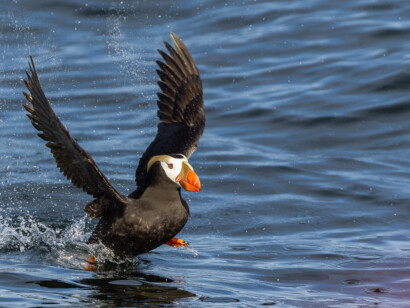
British Columbia Coast & Pelagic

British Columbia Birding with Canadian

Khutzeymateen Grizzly Bears Sailing
- Conservation
- In the media
- Birding blog
- How to book
- Booking FAQs
- Plan your trip
- Land Tour FAQs
- Insurance FAQ
WHERE WE GO
- Mexico & Central America
- South America
- Australia & New Zealand

- Terms of Use
- Privacy Policy
Port Fairy Pelagic Tour - Tour P1
Tour Cost: TBC per person (includes fuel surcharge) Number of Passengers: 21 Facilities: Proper toilet fitted. Accommodation: Additional to cost of tour. Port Fairy has plenty of accommodation. Check out accomondation websites or contact the local visitor information centre for more assistance on 1300 656 564 or 03 5568 2682. Meals: BYO Lunch. Morning tea available on board, please bring your own "keep cup". The group generally meets at one of the local restaurants for dinner on the night prior to tour (additional to cost of tour).
This full day tour can be run on a day to suit. From historical fishing village Port Fairy we head out to the continental shelf, approximately 30nm off shore where the sea floor drops away dramatically.
A pelagic tour is a great adventure and one of the only ways to see some of the world’s spectacular pelagic seabirds and marine mammals.
Touring off southern Australia gives you a wonderful chance of encountering up close and personal our spectacular albatrosses, shearwaters, petrels, storm petrels and more. It is a great opportunity to see dolphins, whales, seals and other marine creatures.
Potential Birds
Potential marine mammals.
As we are sailing off southern Australia tours may have to be cancelled or dates changed due to weather conditions.
Birding in British Columbia
A hub for birding information for British Columbia, Canada. Featuring Rare Bird Alerts, directory to nature clubs and online birding groups, birding forums, and more.
Birding Victoria, BC
When hiking Greater Victoria trails, one can't help notice the diversity of birds that inhabit our local forests, bays and sea-shores. Southern Vancouver Island's geography offers a great diversity of habitats from rocky and sandy shoreline and tidal mud flats to riparian and deciduous forests, to dense old growth cedar and douglas fir stands, and up to inland rocky hilltops and garry oak meadows. This diversity attracts an every changing mix of avifauna and because our region offers favourable habitats for many bird species, Southern Vancouver Island can be a magical place for bird watching.

Victoria Birding Locations
- Birding Hotspots and Site Guides
- Finding Sky Larks
- Rocky Point Bird Observatory
- Victoria Natural History Society
- Race Rocks Ecological Reserve (videocams)
Natural History Events
Victoria Natural History Society Presentation Night Series - Natural History Night - 2nd Tues - 7:30pm. Fraser Building, UVic, Room 159 - Birders Night - 4th Wed - 7:30pm. Fraser Building, UVic, Rom 159
Birding Walks and Tours
Swan Lake Birding Date: Every Wednesday and Sunday Join a local birder for a morning walk around Swan Lake . Meet at 9:00am in the parking lot. Bring binoculars and you field guide.
Victoria Natural History Society Become a member in the Victoria Natural History Society to participate in their outings. Call 250-704-2555 to hear the VNHS events listings or visit the VNHS website .
Sighting Reports
Recent sighting reports for Greater Victoria
Greater Victoria Birding Hotspots
Greater Victoria Species Occurance Bar Charts
Weather & Tides
Southern Vancouver Island Tide Tables
Recommended Guide Books:

This book is designed to help you understand the variety of habitats and natural wonders awaiting your discovery, all in a portable, easy-to-read format. It includes beautiful full-colour photographs, checklists and a map of all the great places to visit.

The book offers detailed trail maps of some of the area birding locations, making it indispensable for birders who like to hike and bird.
Other Travel Guide Books:
- Vancouver and Victoria Colourguide
- Frommer's Vancouver & Victoria 2005
Birding in British Columbia is an online magazine and community message board produced and maintained by K. Slagboom | About
Copyright © K. Slagboom 1997-2024. Web site maintained by Cool New Media .
Our office is currently closed, please email us here!
- Daily Tours
- Packages & Deals
- Custom Charters & Group Tours
- Guaranteed Whales
- Cruise Ship Schedule
- Gift Certificates
- Accessibility
- The Salish Sea
- Responsible whale watching
- Conservation
- Sustainability
- Killer whales & salmon
- What can you do to help?
- Wild 4 Whales Fee
- Whale Wise Guidelines
- 1% For The Planet
- Daily Operations
- Toothed Whales
- Baleen Whales
- Seals, Sea Lions and Otters
Marine Birds of the Salish Sea
- Marine Mammals of the Salish Sea
- Awards & Honours
- Photo galleries
- Video galleries
- Free ZOOM background images
12 Erie St - Fisherman's Wharf Victoria, BC
A bird watcher’s paradise
Bird watching is an essential activity on the south end of Vancouver Island!
The Salish Sea is on the “Pacific flyway” for many different bird species. Birds that spend all or part of their life cycle in the region include the bald eagle, harlequin duck, pigeon guillemot, rhinoceros auklet, common murre, red-necked phalarope, osprey and turkey vulture. There are also many gull and duck species, and a wide range of intertidal and shorebirds including the black turnstone, surfbird, black oystercatcher, and so on. It’s an ornithologist’s dream!
Our knowledgeable and passionate marine naturalists are eager to introduce you to our feathered neighbours. Just in case you aren’t able to join us here in Victoria, here’s a quick guide to some of the most often seen marine birds in the region. From the comfort of your own home, you can experience the biodiversity of one of our marine adventures.
Thank you for being a part of the Eagle Wing Tours adventure…enjoy!
Foot-Propelled Diving Birds

Phalacrocorax penicillatus
Brandt’s Cormorant

Gavia immer
Common Loon

Phalacrocorax auritus
Double-Crested Cormorant
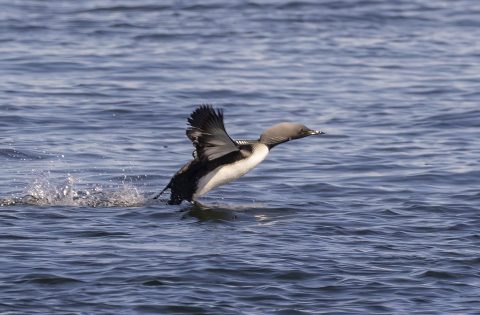
Gavia pacifica
Pacific Loon
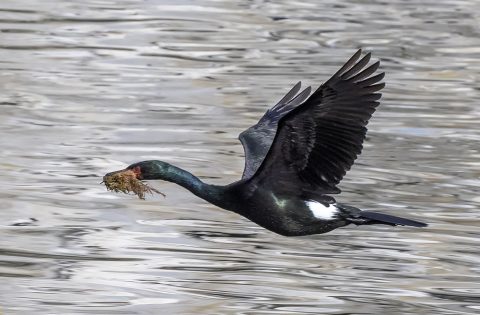
Phalacrocorax pelagicus
Pelagic Cormorant
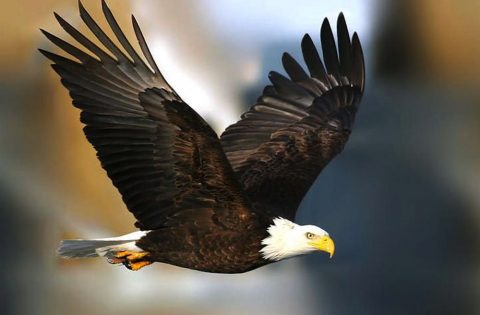
Haliaeetus leucocephalus

Pandion haliaetus
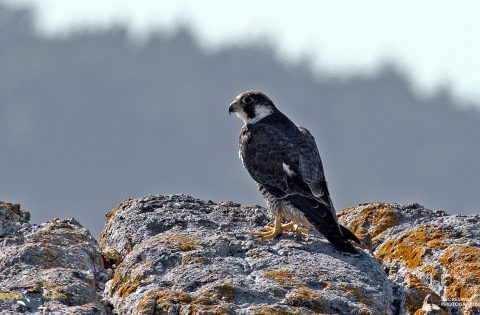
Falco peregrinus
Peregrine Falcon
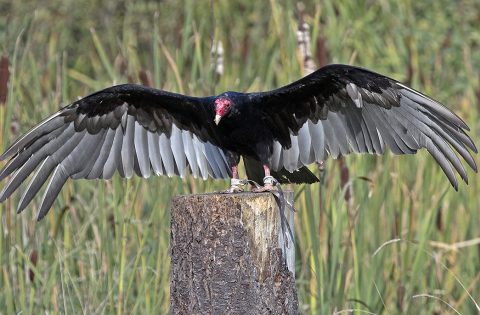
Cathartes aura
Turkey Vulture
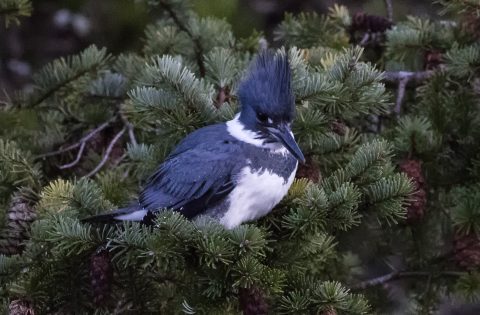
Ceryle alcyon
Belted Kingfisher
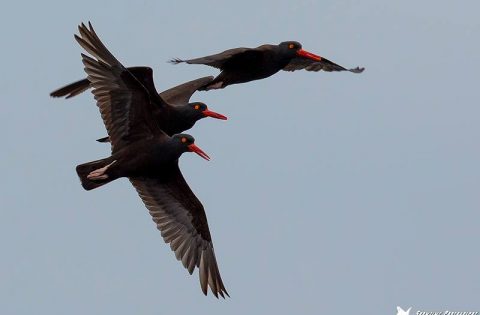
Haematopus bachmani
Black Oystercatcher
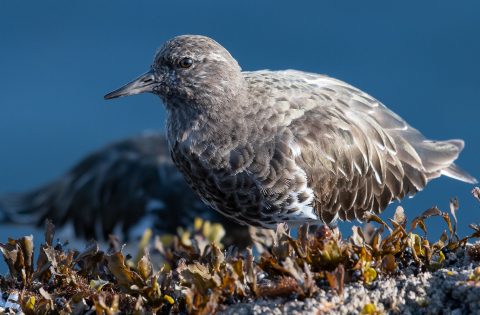
Arenaria melanocephala
Black Turnstone
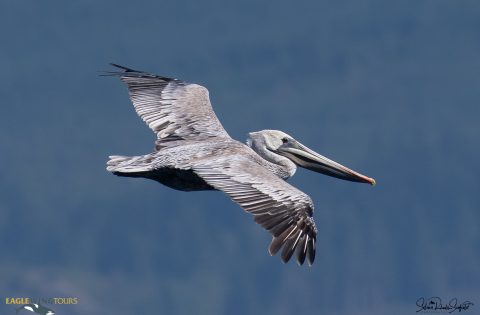
Pelecanus occidentalis
Brown Pelican

Ardea herodias
Great Blue Heron
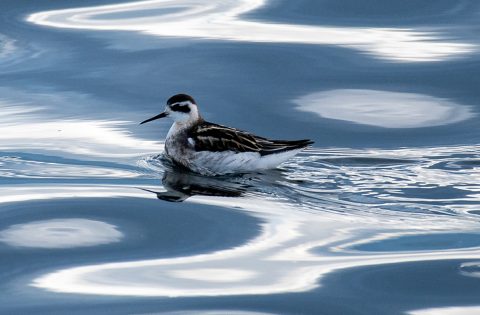
Phalaropus lobatu
Red-Necked Phalarope
Wing-Propelled Diving Birds

Mergus merganser
Common Merganser

Common Murre
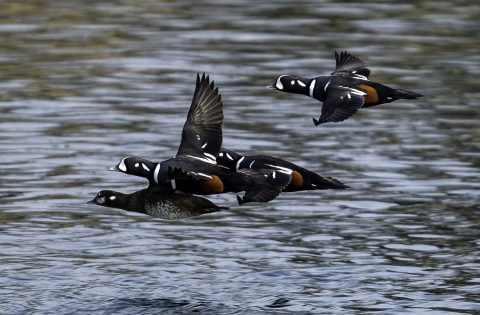
Histrionicus histrionicus
Harlequin Duck
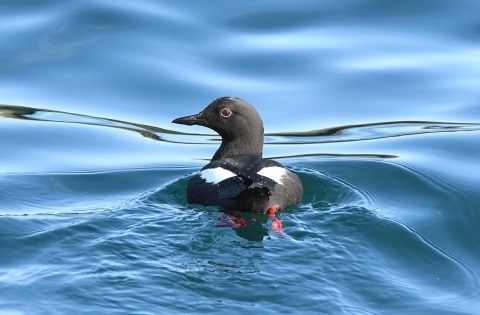
Cepphus columba
Pigeon Guillemot
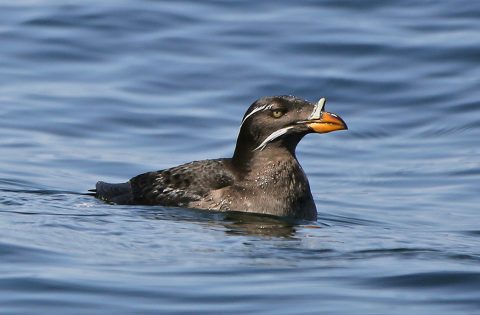
Cerorhinca monocerata
Rhinoceros Auklet
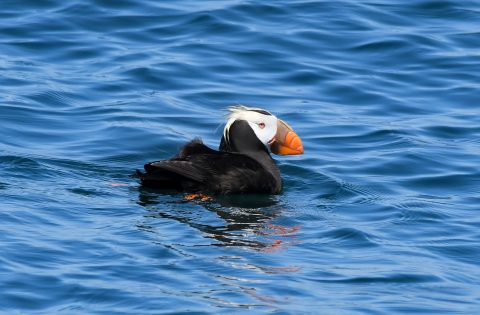
Fratercula cirrhata
Tufted Puffin

Inspiring the conservation of our marine environment, with a thrill!
“It is my hope that the information contained within this guide affects people in such a way that they become infected with the same enthusiasm and passion about wildlife that I possess. One small step at a time towards personal and educational growth which hopefully, some day, will lead to global awareness… beauty of diverse life.” – Brett Soberg
This guide has been compiled by Brett Soberg, lead captain/naturalist and co-owner of Eagle Wing Tours Ltd., so that you from the comfort of your own home, may learn more about these wondrous marine mammals and may not be copied, duplicated or transmitted in whole or part, by any means whatsoever unless prior written permission is obtained from Eagle Wing Tours Ltd. This publication may only be downloaded and printed for an individual’s educational benefit.
Choose A Tour

Half Day Whale & Wildlife Watching Tours – Summer

Full Day Whale & Wildlife Watching Tours – Summer
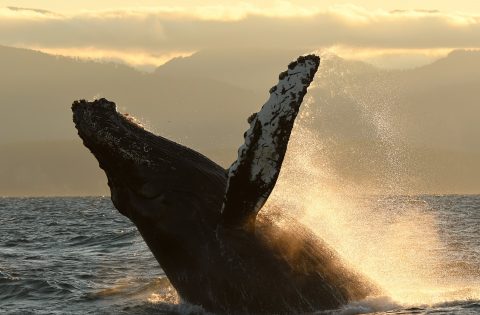
Whale Watching – Summer Sunset Tours

Custom Charters and Group Tours – All Year

Half Day Whale & Wildlife Watching Tours – Winter/Spring
© 2024 Eagle Wing Tours / Privacy Policy / Login
Website by BONE Creative

IMAGES
COMMENTS
Welcome to Birding Victoria and Firetail Birdwatching Tours. This website is a resource for birdwatching and natural history in Melbourne and right around Victoria. You'll find details of tours available, bird species notes, site descriptions and useful resources. Whether you are looking to book on a tour, hire a guide or just researching ...
Melbourne Birding Tours Fully guided bird watching tours. Chris has been a keen bird watcher since his boyhood in England. He founded Peregrine Bird Tours in 1984, offering Worldwide bird watching tours, and 36 years later, Peregrine Bird Tours is still going strong, Chris has observed in excess of 840 species of birds in Australia and its territories.
Our birdwatching and nature tours are available around Melbourne and across the whole state of Victoria. They vary from half day outings to twelve days touring the whole region. All levels of experience are catered for. Gift vouchers are available fro private tours. Please use the contact page for all enquiries and let us know if you are ...
Guided birding tours in the Greater Melbourne region - We offer a variety of bird watching tours encompassing the broad range of habitats found in south-central Victoria. Birdlife in this region is prolific, varied and exciting, and coupled with some of southern Australia's most magnificent scenery only a short distance away from the Melbourne ...
Birding Tours (Melbourne & Victoria) Victoria is one of Australia's most impressive birding states. Though it only makes up around 3% of the continent, this small state still records over 400 species annually, including some of the rarest and most spectacular species in the world, many of which are endemic.
Victoria, Australia's smallest mainland state boasts some terrific birds and a wide variety of habitats. From the eastern temperate rainforests to the dry mallee scrub of the north-west, over 490 bird species have been recorded in this state. Melbourne, the state capital, is surrounded by excellent birding sites.
Box Hill South, Victoria, 3128. Running for 10 days in late November each year the Victorian Megatour aims to showcase this state's best birding sites from the rainforests, heaths and coastlines of the south to the box-ironbark woodlands, grassy plains and semi-arid mallee woodlands of the north, targeting many rare and iconic bird species ...
Victoria's bird emblem - the endangered helmeted honeyeater - can be seen in the Yellingbo Nature Conservation Reserve near Yellingbo, just 50 kilometres east of central Melbourne. Other inspiring city-fringe birdwatching opportunities include Point Cook Coastal Park and Woodlands Historic Park. Bird lovers who are bound to the city will ...
Aus$650-00 total for a single person/couple Aus$750-00 total for 3-4 people - includes drinks and snacks, lunch not included - larger groups are possible. Tour 5. Central Victoria - The Box-Ironbark country. With freeways heading north from Melbourne it is possible to visit the inland slopes of the Great Dividing Range in a day.
Victoria's state bird is the helmeted honeyeater (Lichenostomus melanops cassidix), a subspecies of the yellow-tufted honeyeater. About 20 cm in length, they are actually an endangered species with only 200 left at last count (in 2018). The best place to see the helmeted honeyeater is on the banks of the Woori Yallock Creek near Yellingbo ...
0438 520 780. Visit Website. Send email. Previous. 1/7. Firetail Birdwatching Tours with guide Simon Starr is Victoria's longest running specialist guided bird-watching company with most tours starting and finishing in Melbourne. Firetail Birdwatching Tours offer a wide variety of guided birdwatching, bird photography and general nature tours ...
The upper reaches of the Murray extend through rugged, timbered, hill and mountain country to the alpine grasslands of the Snowy Mountains. The forests and waterways of the Upper Murray create some of the best birdwatching opportunities in the country. Victoria's Box-Ironbark forests are home to the Red-capped Robin, Turquoise Parrot and ...
Birdwatching. Birdwatching is a great way to get into nature and learn more about our incredible native wildlife. It's also a fun and simple activity that's good for improving mental wellbeing. Around 450 species of birds call Victoria home, including many rare and endangered species. Whether you're a seasoned twitcher or brand-new to birding ...
Official site for Melbourne, Victoria, Australia Subscribe. Languages. English 한국어 日本語 中文简体 ... Firetail Birdwatching Tours - Red-capped Robin. Firetail Birdwatching Tours - Ready to explore? Firetail Birdwatching Tours - Guided birdwatching. close.
Firetail Birdwatching Tours, operated by Simon Starr, is Victoria's longest running specialist bird guiding company. A wide range of itineraries are offered from half a day to over a week, specialising in birding and nature tours across the entire state of Victoria and adjacent New South Wales.
REGION 1. MELBOURNE AND SURROUNDS. From open plains and wetlands in the west to mountain ranges in the east, the Melbourne region contains a diversity of landscapes, habitats and birdlife all within easy reach. To the north and west of the city the landscape is part of the Volcanic plains ( see Western Victoria for more detail).
1. Esquimalt Lagoon. One of the best places to go birdwatching in Victoria, BC, is at Esquimalt Lagoon. Located along the Colwood waterfront, this National Migratory Bird Sanctuary (one of seven in Canada!) is a fantastic spot to spot all kinds of species. It's also one of the most beautiful sandy beaches in Victoria!
We'll spend three days exploring birding hotspots near Victoria such as Swan Lake and Martindale Flats, and take a whale-watching tour to view orcas up close. We'll visit the wild west coast near Tofino for a pelagic tour that opens up a world of possibilities for seabirds, and comb the beaches in hopes of whimbrels, eagles and perhaps even ...
Number of Passengers: 21. Facilities: Proper toilet fitted. Accommodation: Additional to cost of tour. Port Fairy has plenty of accommodation. Check out accomondation websites or contact the local visitor information centre for more assistance on 1300 656 564 or 03 5568 2682. Meals: BYO Lunch.
Birding Walks and Tours. Join a local birder for a morning walk around Swan Lake. Meet at 9:00am in the parking lot. Bring binoculars and you field guide. Become a member in the Victoria Natural History Society to participate in their outings. Call 250-704-2555 to hear the VNHS events listings or visit the VNHS website.
Links below will take you to site descriptions for the best birding areas in each region plus information on geology, climate and vegetation types. Melbourne and Surrounds. The Inland Slopes -Box-Ironbark country. The Riverina. Western Victoria. The Mallee, North-West Victoria. Gippsland. Useful bird watching resources from Birding Victoria.
Victoria's bird emblem - the endangered helmeted honeyeater - can be seen in the Yellingbo Nature Conservation Reserve near Yellingbo, just 50 kilometres east of central Melbourne. Other inspiring city-fringe birdwatching opportunities include Point Cook Coastal Park and Woodlands Historic Park. ... He founded his bird watching tour company ...
A bird watcher's paradise. Bird watching is an essential activity on the south end of Vancouver Island! The Salish Sea is on the "Pacific flyway" for many different bird species. Birds that spend all or part of their life cycle in the region include the bald eagle, harlequin duck, pigeon guillemot, rhinoceros auklet, common murre, red ...